
- icon-chevron Hardware
- View all icon-chevron
- icon-chevron Hinges & Latches
- Butt Hinges icon-chevron
- Offset Hinges icon-chevron
- Butterfly Hinges icon-chevron
- Embossed Ornamental Hinges icon-chevron
- Specialty Hinges icon-chevron
- Art Deco Hinges icon-chevron
- Cupboard Latches icon-chevron
- Cabinet Catches icon-chevron
- Cabinet Bin Pulls icon-chevron
- icon-chevron Knobs & Handles
- Furniture & Cabinet Handles icon-chevron
- Glass Handles icon-chevron
- Glass Knobs icon-chevron
- Porcelain Knobs icon-chevron
- Decorative Knobs icon-chevron
- Simple Square Knobs icon-chevron
- Simple Round & Oval Knobs icon-chevron
- Wooden Knobs icon-chevron
- icon-chevron Doors & Windows
- Keyhole Covers icon-chevron
- Doorknob Trim Plates icon-chevron
- Knobs icon-chevron
- Hinges icon-chevron
- Skeleton Keys icon-chevron
- icon-chevron Chairs
- Fiber Seats icon-chevron
- Caning & Rush Supplies icon-chevron
- Strand Cane icon-chevron
- Machine Woven Supplies icon-chevron
- Chair Repair Parts icon-chevron
- Glides icon-chevron
- Casters icon-chevron
- Morris Chairs icon-chevron
- icon-chevron Furniture
- Pulls & Knobs icon-chevron
- Inserts & Handles icon-chevron
- Furniture Wood Screws icon-chevron
- Repair Products icon-chevron
- icon-chevron Fasteners
- Trunk Fasteners icon-chevron
- Table Hardware icon-chevron
- Table Levelers & Fasteners icon-chevron
- Bed Hardware icon-chevron
- icon-chevron Wood Screws
- Oval Wood Screws icon-chevron
- Round Head Wood Screws icon-chevron
- Slotted Flat Head Wood Screws icon-chevron
- Antique Tea Cart Rubber icon-chevron
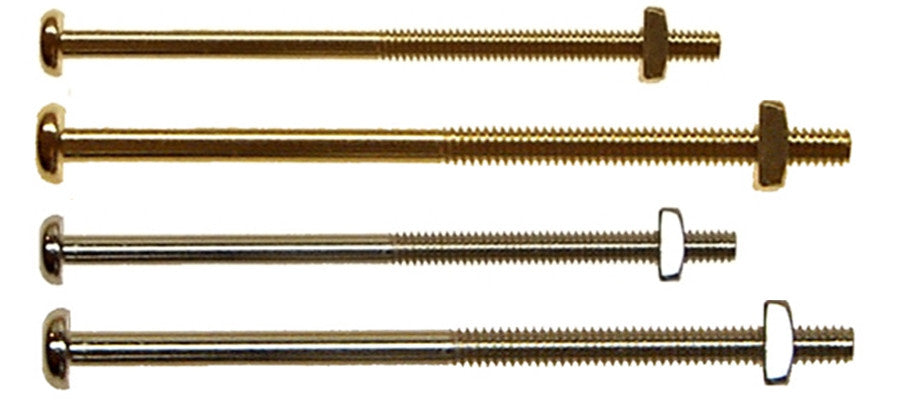
- icon-chevron Trunk Restoration
- Trunk Slat & Edge Clamps icon-chevron
- Trunk Handle Caps & Loops icon-chevron
- Trunk Rollers icon-chevron
- Trunk Corners icon-chevron
- Trunk Drawbolts icon-chevron
- Trunk Locks icon-chevron
- Trunk Stays and Hinges icon-chevron
- Trunk Lithographs icon-chevron
- Trunk Leather Items icon-chevron
- icon-chevron Chair Restoration
- Danish Cord icon-chevron
- Fiber Rush & Supplies icon-chevron
- Machine Woven Cane & Supplies icon-chevron
- Seat Weaving Books icon-chevron
- Strand Cane & Supplies icon-chevron
- Upholstery Tacks icon-chevron
- icon-chevron Stains & Finishes
- Wood Stains icon-chevron
- Finishes icon-chevron
- Glues icon-chevron
- Fillers icon-chevron
- Waxes icon-chevron
- Kitchen Queen & Pie Safe icon-chevron
- icon-chevron Tables
- Drop Leafs icon-chevron
- Table Locks icon-chevron
- Table Pins icon-chevron
- icon-chevron Shop by Category
- icon-chevron Furniture Hardware
- Locks & Keys icon-chevron
- Casters & Wheels icon-chevron
- Escutcheon Pins icon-chevron
- icon-chevron Wood Restoration
- Veneers icon-chevron
- Wood Fillers icon-chevron
- Stains & Finishes icon-chevron
- Wood Plugs icon-chevron
- icon-chevron Specialty Restoration
- Trunk Restoration icon-chevron
- Leather Items icon-chevron
- Chair Restoration icon-chevron
- Antique Tea Cart Restoration icon-chevron
- Hooks icon-chevron
- Washers icon-chevron
- Mirror Hardware icon-chevron
- icon-chevron Tools & Accessories
- Brushes & Applicators icon-chevron
- Sanding & Scraping icon-chevron
- Cleaning Supplies icon-chevron
- Popular icon-chevron
- Clearance Items icon-chevron
- Blog icon-chevron
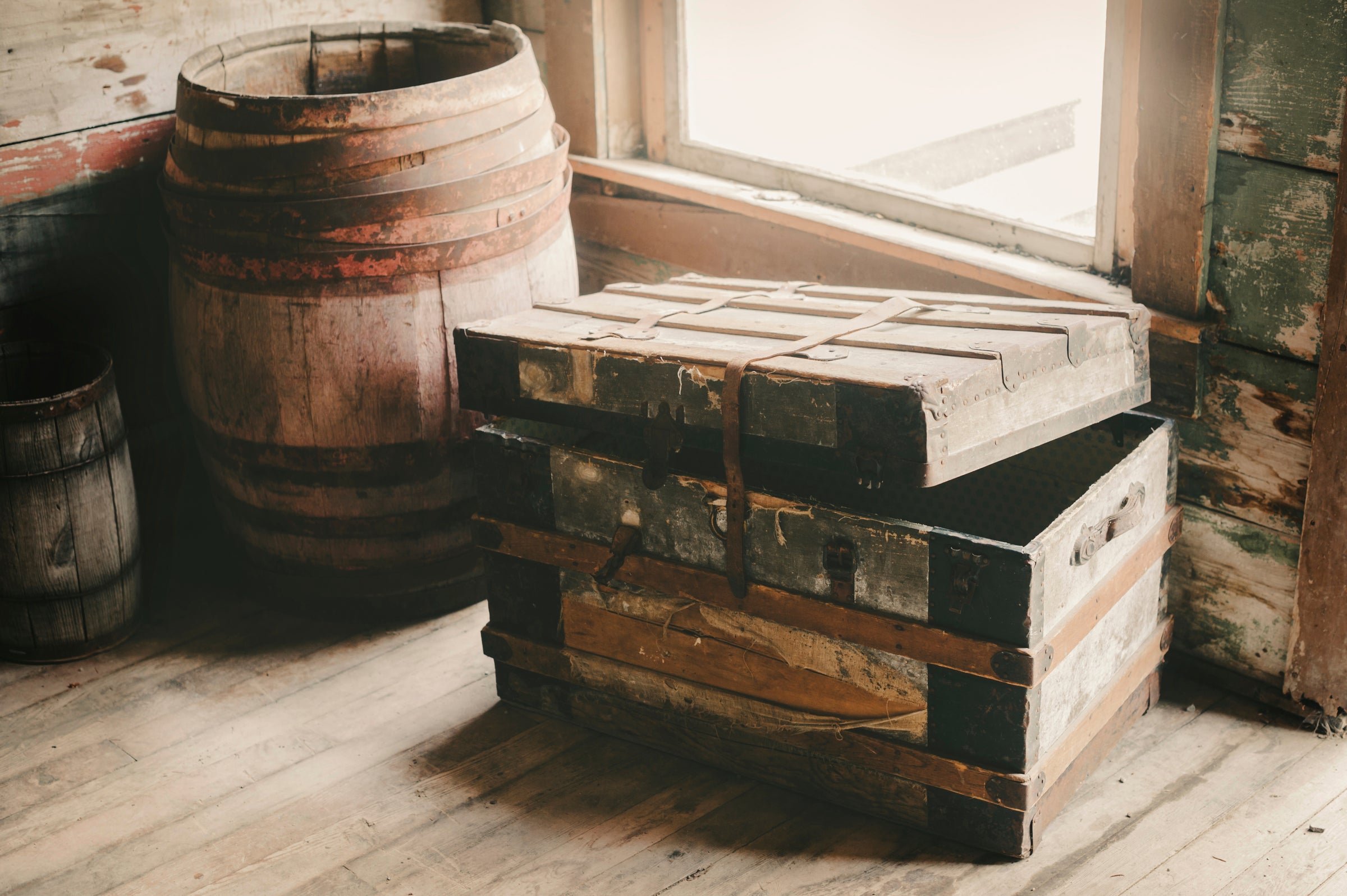

Trunk Restoration
- Best selling
- Alphabetically, A-Z
- Alphabetically, Z-A
- Price, low to high
- Price, high to low
- Date, old to new
- Date, new to old
- In stock (59)
- Out of stock (12)
- Cast Iron (1)
- Hand Aged Brass (1)
- Antique Brass (5)
- Antique Copper (1)
- Hand Antiqued Brass (1)
- Nickel Plated (1)
- Polished Nickel (4)

Few things so clearly have a story to tell like an antique trunk. In our years of restoring antique furniture, I’ve often said of a piece of furniture, “If only it could talk…” & nothing is truer than with a trunk. When you realize what it’s purpose originally was, (transporting & storing belongings) many questions come to mind. Did it travel on a covered wagon? (We once restored a trunk that came over on the Oregon Trail!) Did it board a steam ship to cross the ocean, like the one in our shop right now that came from Norway, or a train to make its way across country?
Although trunks have been around for thousands of years in China and elsewhere, the most common styles seen and referred to today date from the late 18th century to the early 20th century. At that point they started to be replaced by the cheaper and lighter suitcase.
Many times, old trunks have been sitting for years in an attic or cellar, and are in pretty poor condition: but even so, trunks are almost always repairable & the transformation can be incredible! We have replacement leather handles , brass corners , fasteners , rollers , locks & many more items to help you with your project.
We also have a guide to restoring your antique trunk .
Welcome to the incredible world of trunk restoration!
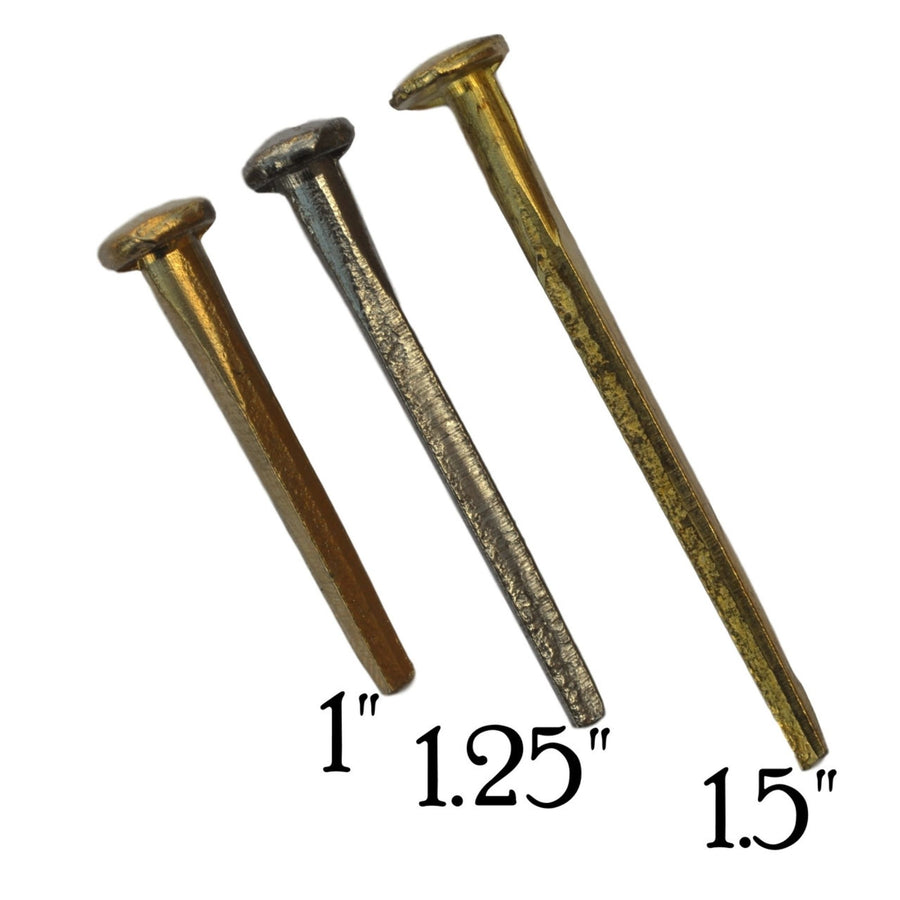
Customer Service
- Shipping & Delivery
- Check Order Status
- Instructions
- Climate Commitment
- Create an Account
Get in touch
- instagram Instagram
Antique Trunk Restoration Tips to Revamp It Like a Pro
Kate is an experienced writer who has written hundreds of articles for publication.
Learn about our Editorial Policy .
Antique trunk restoration is a labor of love, but it's also a simple DIY job. With some basic tools and supplies and little time, you can restore the beauty of your old trunk and bring it back to useful condition. Restoring old trunks involves assessing their condition, solving problems like mildew and rust, and even replacing the artwork that graces many trunk lids. These tips can help you restore an antique trunk like a pro.
Assess the Condition Before Restoring Old Trunks
Before you begin any antique trunk restoration job, you need to assess the trunk's condition. This is the first step of professional trunk restorers, and it should be your first step too. According to Gary Daniel of Shenandoah Trunk Restoration , he always checks the trunk over before planning out the restoration process. "We evaluate it and note damage, prior restorations, rust, and other problems," Daniel says. These are the problem areas you may need to fix as you work on the trunk.
- Grab a piece of paper and a pencil and begin making notes about damage to the trunk.
- Starting on the outside, go over the trunk carefully, checking its condition. Does it have rust or broken hardware? What about chips or scratches?
- Look inside the trunk too. Does it have an odor or obvious mildew and grime? Is the artwork still in good shape?
- Note everything on your list and then proceed with your restoration.
- Pictures of Antique Hand Tools and Their Usage
Remove Damaged Materials and Fix Problems
After you've noted what's wrong with the antique trunk, it's time to start fixing problems. You need to remove any damaged materials, including rusty hardware, torn or stained paper linings, chipping paint, and other surfaces. Then you begin building it back up. "We completely tear it down," Daniel says. "We do any needed repairs and even replace artwork if necessary." Some of the solutions you may need to try include the following:
- Use a scraper and water to remove stained and damaged paper inside the trunk. Lightly spray the paper, but don't soak the inside of the trunk.
- Place the trunk outside in the sun to remove odors. You can also spray it with a weak bleach solution if you suspect mold.
- Remove rusty parts and use a wire brush or sandpaper to scrape off the rust.
- Remove rotten leather and other damaged parts.
Try to Bring the Trunk Back to Original Condition
After you've removed any damaged parts and cleaned the antique trunk, the restoration process continues. Your end goal should be to restore the trunk to its original condition. You'll need to purchase replacement parts such as new handles, hardware, and lining paper from retailers like the Furniture Restoration Center of Oregon . "Once the repairs are done, we build the trunk back up with new leather, buffed hardware, and original paint colors," Daniel says. "We line the inside and whatever else it takes to get it back to the original condition."
Understand How Antique Trunk Restoration Affects Value
It's no secret that restoration can affect the value of antiques . However, in the case of trunks, functionality and beauty are sometimes more important than original condition. According to Daniel, the only trunks you should avoid restoring are those that are museum piece or very rare antique trunks. In most cases, restoration can enhance antique trunk values. " If you are going to use the trunk as décor in your home, then it is better to restore it," he says. "It adds value and makes it more useful."
Learn About Your Antique Trunk Before Restoring It
Because there are a few antique trunks you shouldn't try to restore, it's a good idea to learn as much as you can about your trunk before you begin any restoration process. Ask yourself a few questions to find out whether your trunk is valuable and whether it's a good candidate for DIY antique trunk restoration.
How Do You Know if Your Trunk Is Antique?
Trunks were extremely popular during the late 19th and early 20th centuries, and then they went out of style in favor of vintage suitcases . Because of this, if you encounter an old trunk, it's likely to be antique. You can use the antique hardware to date your trunk, since the types of nails, clasps, hinges, and keyholes can offer clues about how old it might be. You can also look for brands that were popular, including Taylor, Clinton, Malloy, Oshkosh, and Swayder Trunk Company.
What Type of Antique Trunk Do You Have?
There are a number of different styles of antique trunks you may see. The main differences in these styles is the shape of the trunk:
- Flat-top trunk - A flat-top trunk has a lid that is level and flat, rather than rounded. Often made of leather, wood, canvas, or metal, these trunks were easy to stack for travel. Flat-top trunk restoration involves ensuring the top is level and attractive, making it useful as a coffee table if you like decorating with vintage items .
- Dome-top trunk - This type of trunk has a domed lid. Dome-top trunks frequently have decorative tin and wood details. Dome-top trunk restoration involves ensuring the structural integrity of the lid and also replacing any internal storage compartments inside the lid.
- Jenny Lind trunk - Rarer than flat-topped and dome-topped trunks, Jenny Lind trunks have a distinctive shape similar to a loaf of bread. The top is curved. These trunks are often made of wood.
- Wall and dresser trunks - Made to sit against a wall, these trunks have a vertical design and sometimes drawers for storage. They are quite rare to find in good condition.
Is Your Antique Trunk Valuable?
According to Daniel, there are certain trunks that are especially valuable. He notes that wall trunks and leather-covered trunks in good condition are often worth the most money, followed by dome-top tin trunks and canvas-covered flat-top trunks. "Other types of desirable trunks are the dresser trunks used by traveling entertainers, antique Louis Vuitton trunks, and very ornate Victorian trunks," he says.
Antique Trunk Restoration Is Approachable
Sometimes, all your trunk may need is a good cleaning. Review some tips for cleaning antique furniture and give that a try. However, if it needs more work, this is a project that is approachable. "Antique trunk restoration can be a very nice do-it-yourself project if you are so inclined," Daniel says.
Just the Woods | a Colorful Home & Healthy Lifestyle Blog
a Colorful Home & Healthy Lifestyle Blog
How to Restore an Old Steamer Trunk in a Few Simple Steps
Share & Save for later!
Steamer trunk restoration project where I show you how to remove mildew odor, secure old labels and learn How to Restore an Old Steamer Trunk in a few simple steps. This antique trunk restoration project shows you how to restore an old trunk .
If you need help with an old trunk restoration then follow along and see how to restore a steamer trunk.
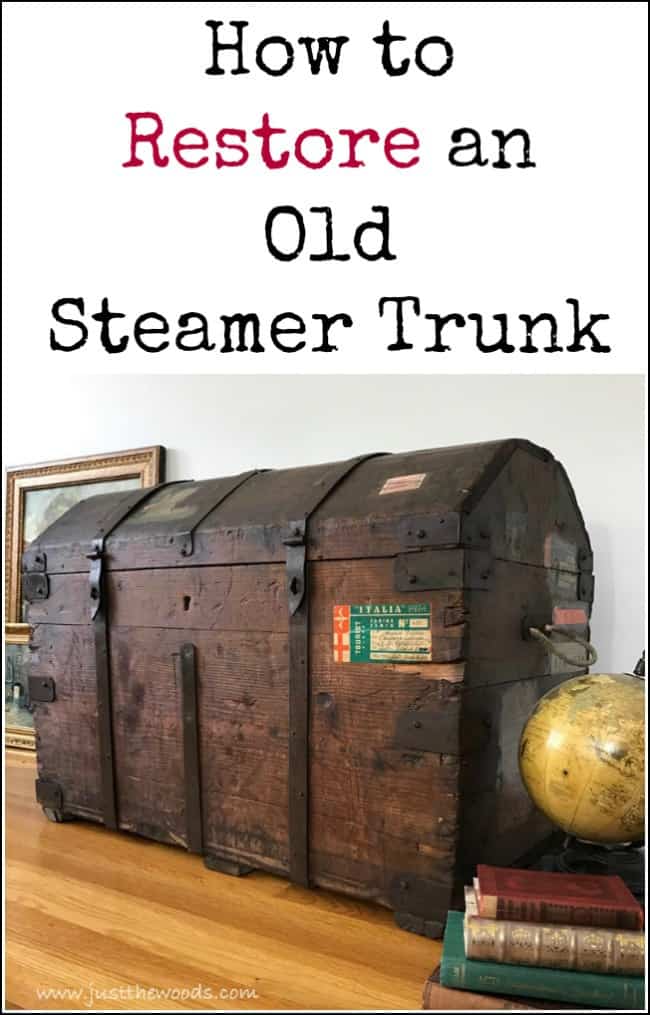
Disclosure: This post contains affiliate links for your convenience. Click here for my full disclosure policy
What is a Steamer Trunk?
Have you heard of steamer trunks ? Have you ever wondered what is a steamer trunk or what makes it different from any other wooden trunk or chest?
A steamer trunk actually got its name because it was designed to be used aboard a steamship, also known as a “steamer”. These sturdy wooden travel chests were popular in the late 1800s and early 1900s for those traveling long distances aboard these ships. Which is exactly where this particular antique trunk came from.
Disclosure: This post is sponsored by Wise Owl and contains affiliate links for your convenience. Click here for my full disclosure policy .
Antique Trunk Restoration
When restoring an old trunk you will need a few things to make the trunk restoration go easier. The condition of your steamer trunk will determine how much work it needs. In general, these are the things that you will need:
Materials Needed / Source List :
- Furniture Dollies
- Wise Owl Lemon Salve
- Clean Rag or Old T-shirt
History of a Steamer Trunk
This old antique chest is a true family heirloom. It had been used by my husband’s great-grandparents as wardrobe trunks as they traveled back and forth between Italy and Staten Island. Many of the vintage labels are still visible on the trunk. The multiple trips between New York and Europe took a toll on this wooden chest leaving evidence of its history as well, making it that much more important to be restored.
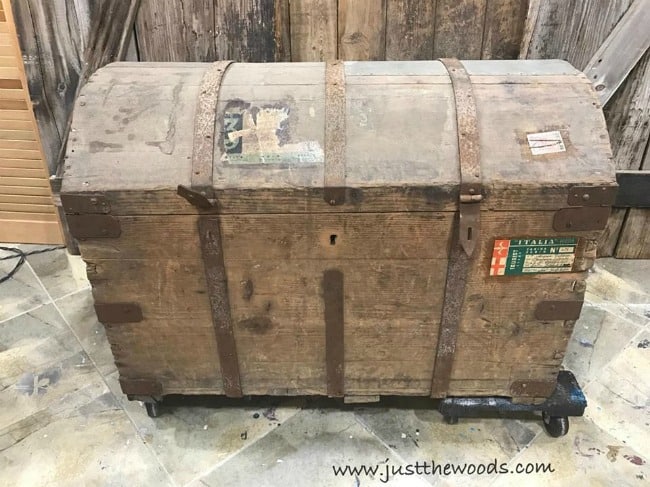
A steamer trunk restoration is easier than you may think once you tackle a few obstacles. There are always a few obstacles. In the case of this steamer chest here are the main issues :
- spider webs
- mildew odor
- labels falling off
Restoring an Old Trunk
Let’s address these issues and small repairs.
The first thing you want to do is clean off as much of the dust and spider webs, and basic yuck as you can. Grab your shop vac and thoroughly vacuum all of that crud off of this old trunk. Don’t forget to tilt the trunk or lay it down to get underneath. I avoid using the house vacuum for things like this and use a shop vac dedicated to these furniture projects. The thought of antique spiderwebs in the vacuum that cleans my living room grosses me out. If you don’t have a shop vac you can find one ( here )
Also, you want to remove some of the dust while not damaging the already delicate wood. Lightly brush the wooden travel chest with a dry paintbrush to ‘dust off’ the dust and dirt. Do not sand or scrub the wood.
Click here to Pin this post for later .
How to Remove Mildew Odor From Wood
This step is a little harder than the first. This antique steamer trunk started with such a strong mildew odor from water damage that I would not allow it into my home. It had spent many years in a basement after all of its trips back and forth to Europe. Words can’t describe how bad the trunk smell was. There are numerous methods for how to remove mildew smell from wood . I’m sharing my method.
The first step to rid this large steamer trunk of the stench is to air it out. I left the trunk in my storage unit for a couple of months with the lid open before bringing it into the shop. This helped but certainly did not do the job completely. If possible, let the old steamer trunk sit in sunlight to air out as well. Make sure not to leave it outside where it could get rained on though.
My next step is to spray the vintage steamer trunk with OdoBan .
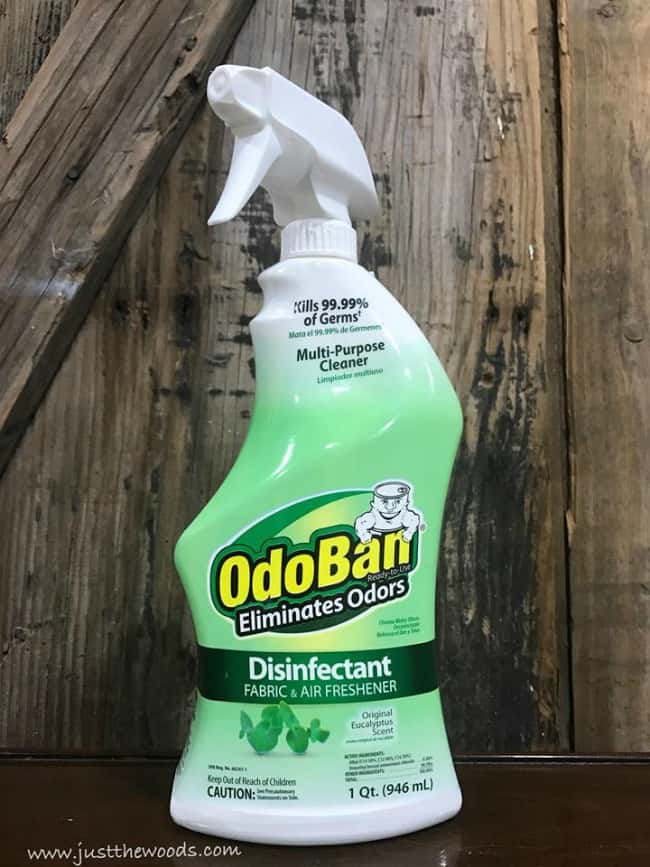
Odoban is a spray disinfectant and odor eliminator. It is not magic, but it helps.
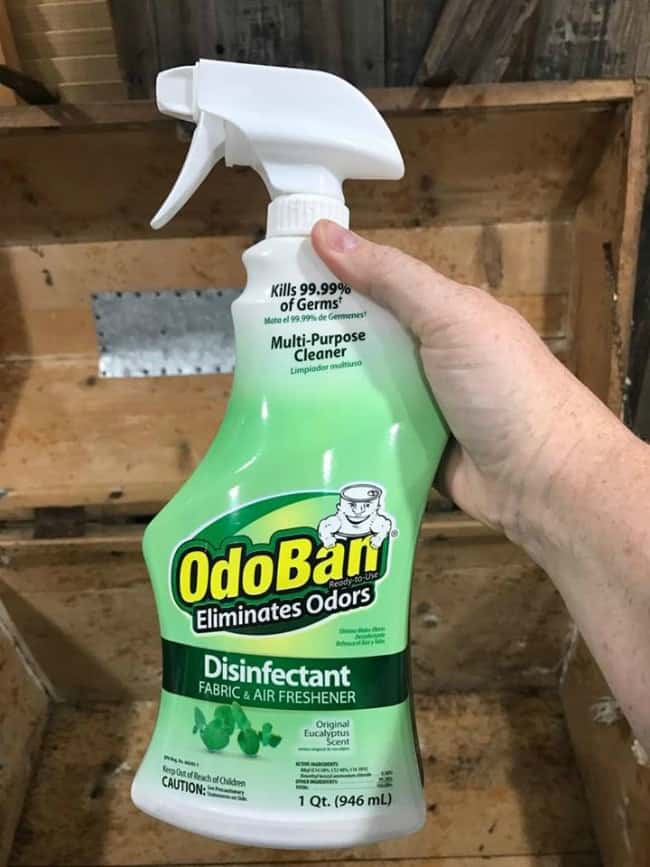
The inside of the wooden chest is lightly sprayed with OdoBan . Do not drench the wood.
This will take a few rounds. Over the course of at least a few days, lightly spray the inside of the wooden trunk multiple times. Make sure to let the spray dry completely before spraying again. You can find OboBan ( here )
Secure Loose Vintage Labels
The vintage steamer trunk is covered in many of the original labels. Most are brittle and falling off. The goal is to safely preserve as many of these old labels as possible while also preserving the original construction of the antique trunk.

Grab your Mod Podge and a small paintbrush.
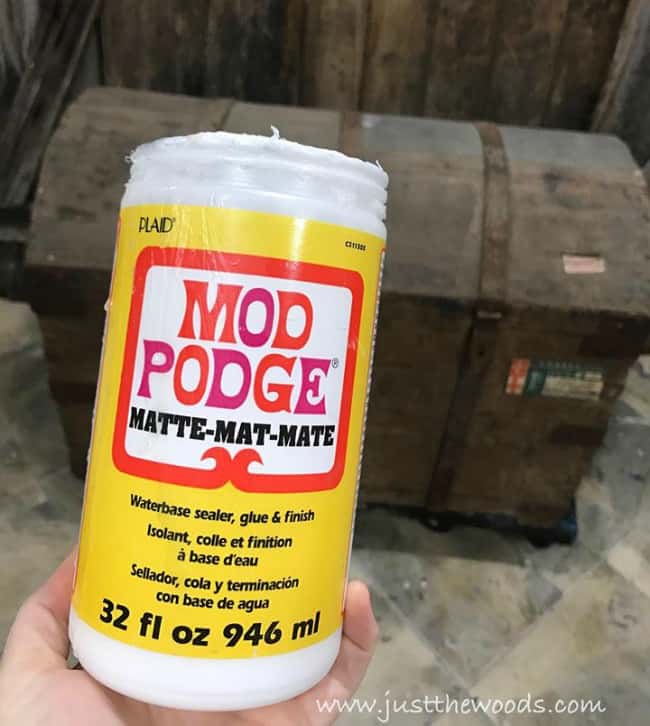
Very gently apply the Mod Podge underneath the loose labels paper edging.
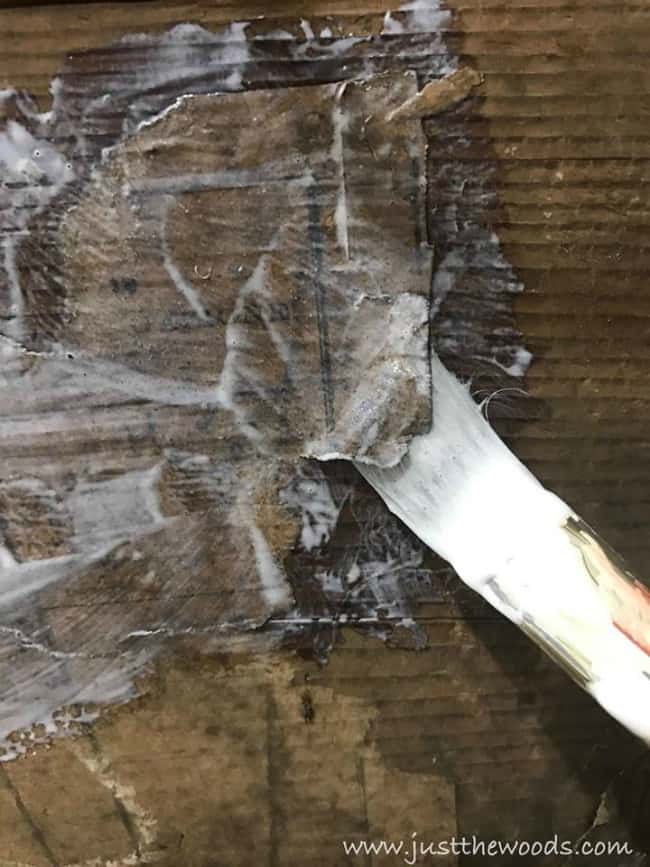
Next, press the label down and apply more Mod Podge over the labels.
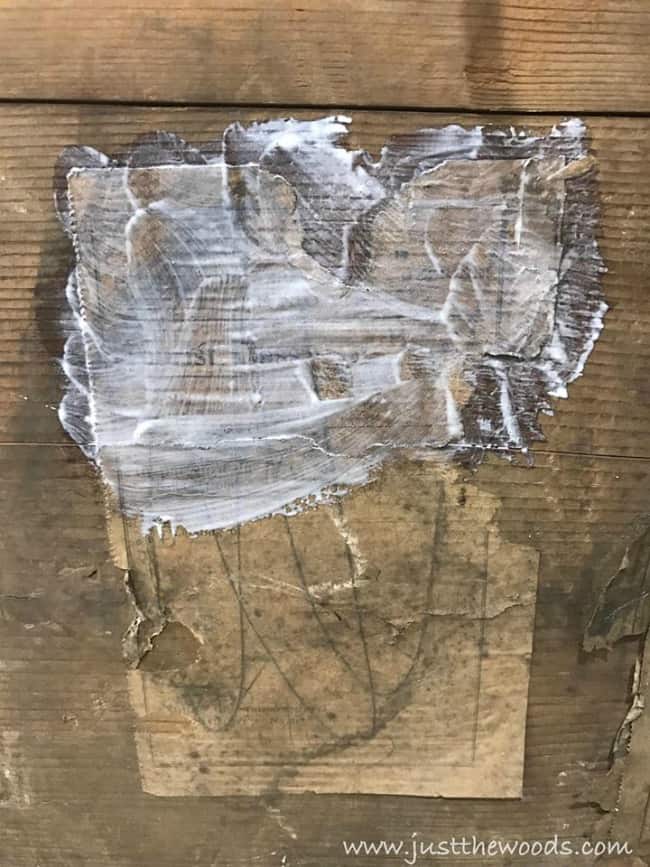
Let the Mod Podge dry completely.
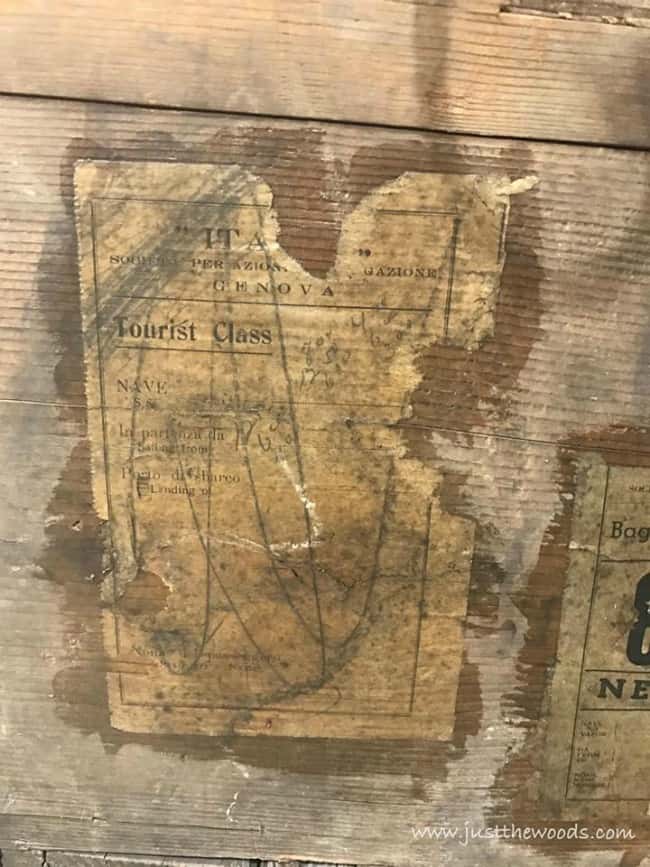
Click here to Pin this post for later
How to Restore a Steamer Trunk
Now that the small obstacles are out of the way we can focus on the important part, the steamer trunk restoration . My good friend Thea has been raving about her Wise Owl Lemon Verbena and how great it smells and works. Wise Owl was kind enough to send me some Lemon Verbena Furniture Salve to try out for myself. If you’d like to try it too, you can get some ( here ).
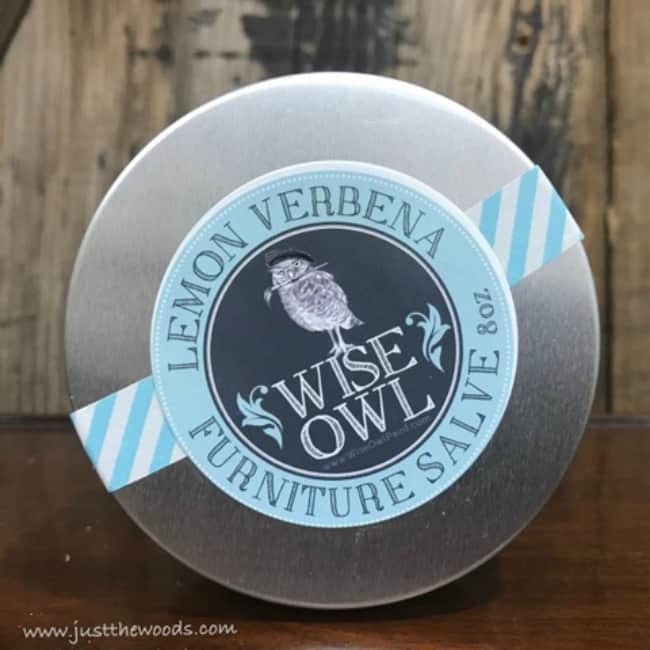
Since this is a furniture salve product I do not want to use the same brush that I would use with my paint. So make sure to use a brush dedicated just to this type of application. Im using a wax type brush . You can find this kind of brush ( here ).
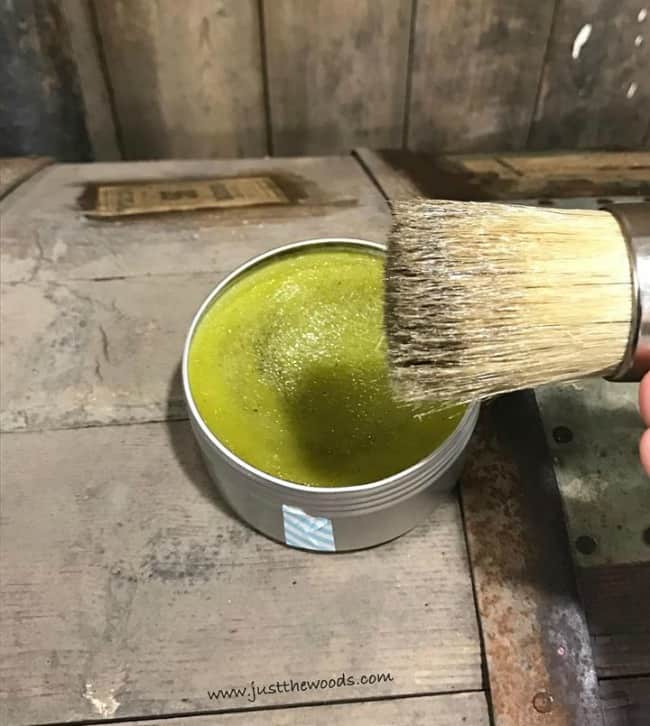
Using your dedicated brush apply the lemon verbena to this beautiful piece of furniture , including the inside of the steamer trunk.
Work the furniture salve into the wood slats as well as gently apply it over the labels.
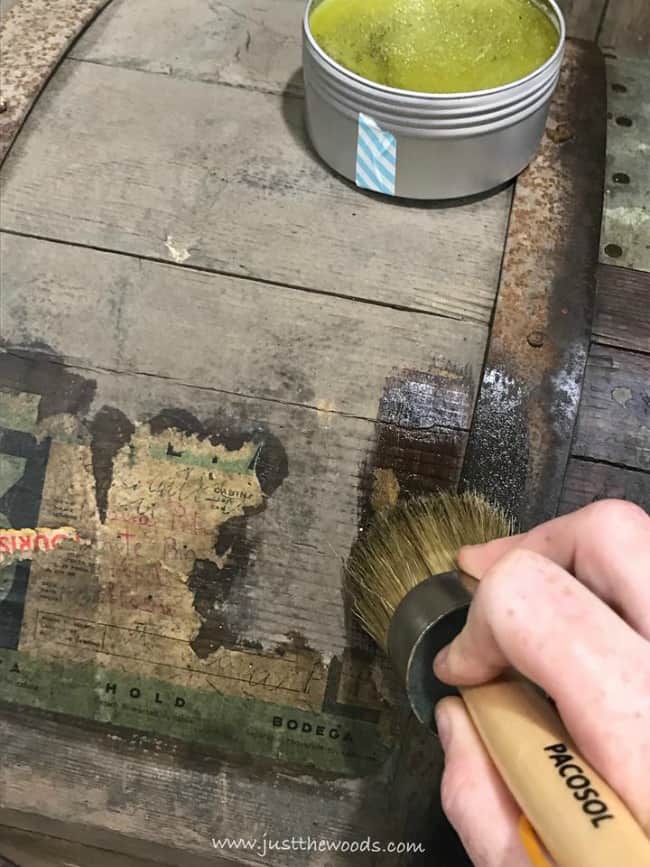
The Wise Owl lemon verbena conditions, seals and protects the wood. But unlike wax, it does not harden leaving a softer and heavenly-smelling result. This furniture salve is m ade with hemp seed oil, natural waxes, cold-pressed lavender essential oil, and lemon verbena oils. Plus other awesome natural goodness that adds to the strength and superpowers of the salve.
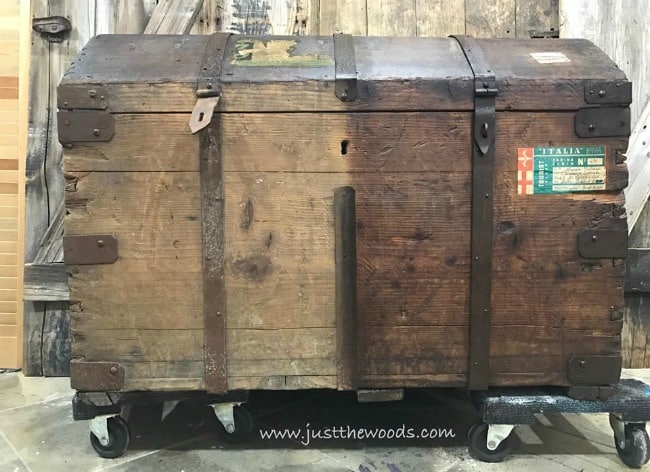
You can see here how much of a difference the verbena makes on the steamer trunk . What a difference, right? As an added bonus you can even use Wise Owl lemon verbena on the metal work of the steamer.
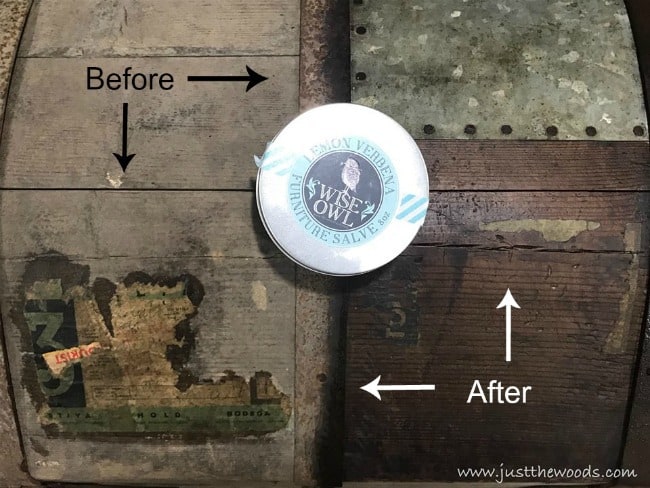
Classic steamer trunks may have leather handles, or in the case of this vintage trunk, simple rope handles. Whichever type your trunk has try to keep the original handles and hardware if possible. Keeping as much of the trunk in its original condition will preserve the vintage and unique look of the trunk.
Watch the Complete Restoration in the Video
Here is a pre-recorded video done live on Facebook . It’s approximately 30 minutes long, but you are able to fast-forward as needed or hang out for the whole video. Many questions can be answered by watching the video, or at least I hope they are. This video will confirm that using the verbena is the best way to achieve a naturally cleaner look on your steamer trunk restoration.
Once the Wise Owl verbena is applied to the entire steamer trunk make sure to go back and buff any excess salve with an old T-shirt.
Especially on the metal areas since the product does not absorb into the metal. But here’s a fun fact: Apply and buff well where it’s very dirty to remove the oxidation from metal and remove dirt and debris. How cool!
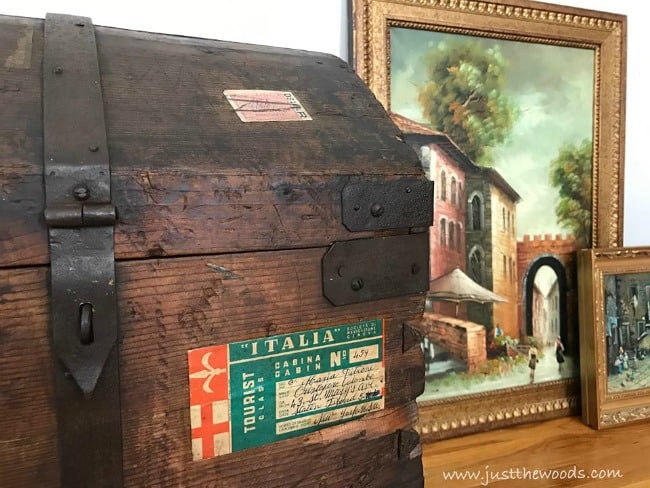
Click here to get Wise Owl verbena . If you would like to check out all of Wise Owls products, including the chalk synthesis paint, primer, wax, glazes, sealers, and more you can find them all here: Wise Owl Products .
If you are a furniture restorer or furniture painter you should also check out How to Save Wooden Drawers with Lemon Verbena .
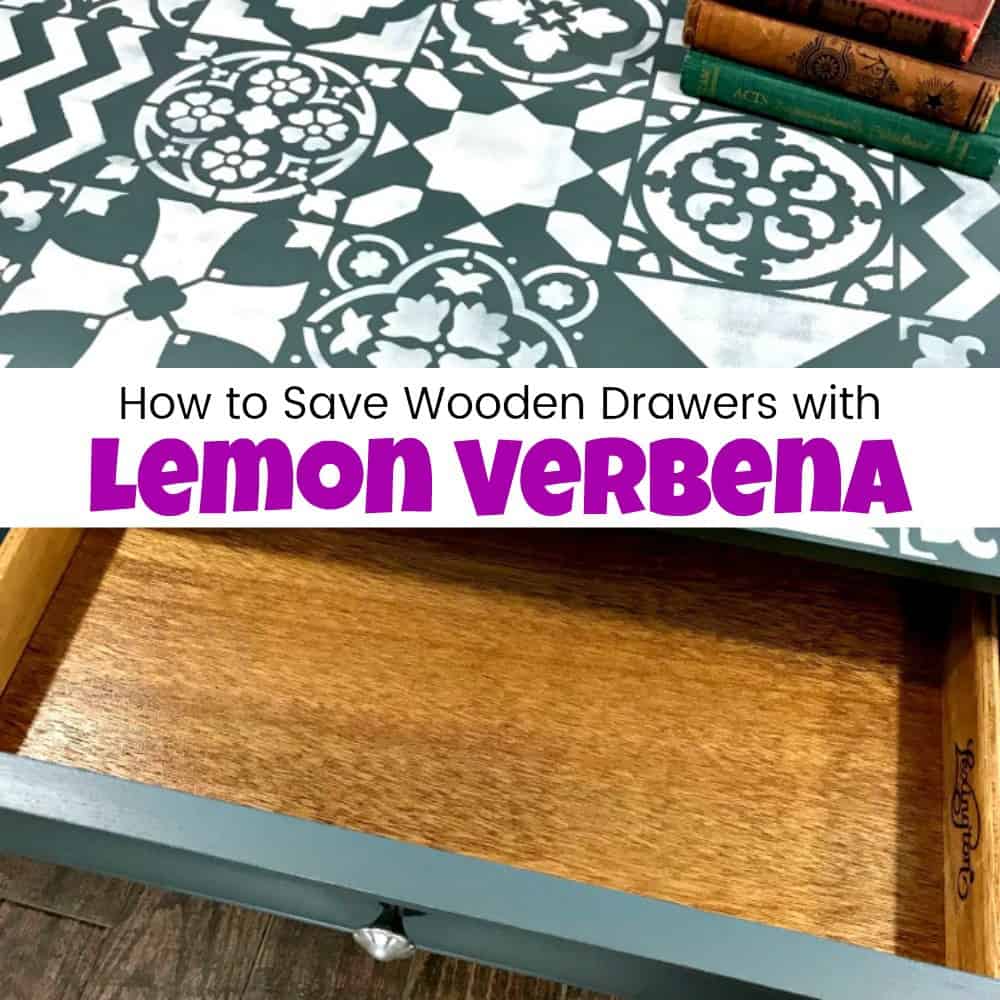
Restoring an Old Steamer Trunk in a Few Simple Steps
How easy was that? Restored and revived while still preserving age and history. This refurbished steamer trunk can now continue on in our home with a new life. My only condition is that it does NOT get filled with toys!
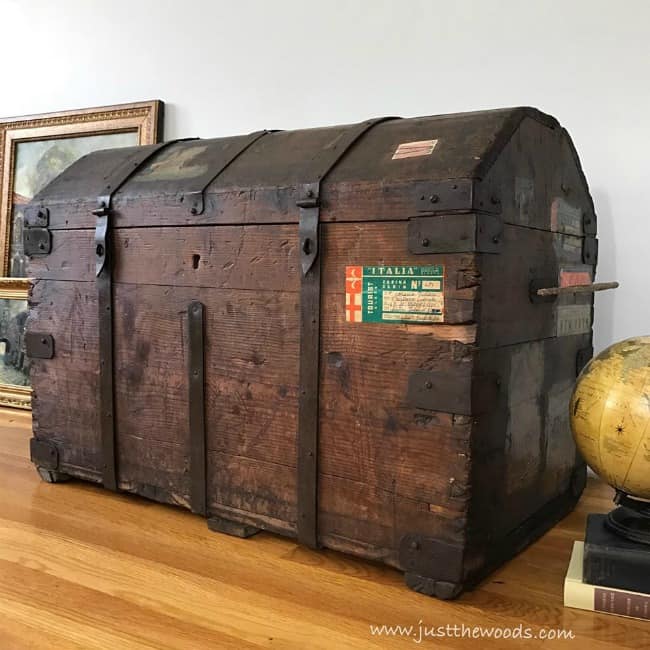
Love steamer trunks but prefer to avoid the restoration process. Looking for a newer version. Find steamer trunks for sale ( here )

Don’t Forget – Follow Just the Woods and Share this post to Inspire others:
FACEBOOK * INSTAGRAM * PINTEREST

Linda at Mixed Kreations says
November 15, 2017 at 5:32 am
What a lovely old trunk! You did a great job restoring it’s old beauty. I’m glad that you were able to save the labels, that’s part of the history and beauty of the trunk.
January 25, 2018 at 7:30 am
Is it possible to get replacement lock for my trunk.. have done much aa you suggested..thanks Sean in Ireland
Michele says
November 15, 2017 at 1:43 pm
Kandice, My husband and I both enjoyed the photos of the restoration of your trunk. We are glad you were able to preserve the travel labels. This is now a lovely family heirloom. Thank you for sharing the photos and the restoration process. Michele
kandice kullmann says
November 15, 2017 at 1:44 pm
thank you so much Michele xoxo
Felicia Thomason says
January 22, 2018 at 10:21 pm
What are your recommendations regarding where to find replacement parts such as handles & casters?
January 23, 2018 at 9:03 am
Felicia, Id probably try ebay for those
Debby George says
January 25, 2018 at 2:14 pm
I have inherited my great grandmothers streamer trunk. But before I received it, it was painted black and now I am wondering how to get the black paint off and hopefully get it back down to the natural wood. Any suggestions would be helpful. Thank you Debby
January 25, 2018 at 3:21 pm
You will probably have to strip the paint off. My understanding is that soy gel stripper is the safest product out there and works well top. Citristrip is another. I hope you’re able to save it!
Carisse says
March 11, 2018 at 12:30 pm
I cannot wait to buy this wise owl. What a beautiful piece.
Carolyn Lewis says
April 27, 2018 at 6:27 am
I have my grand mother’s trunk from 1904, when she immigrated to America from Finland. I’ve been looking for the perfect restoration answer, I believe I have found that answer right here. My question is, the entire inside of the trunk is covered with paper. I’m trying to decide if I want to leave it, or remove the paper. Will ModPodge help reinforce the paper and preserve it as well? Also, over the years of storage, someone put moth balls in the trunk, even though they are gone, the inside stinks from them. Do you think the OdoBan product will help eliminate that kind of odor?
Also, I believe the lock does not work, I haven’t tried to push it into the locked position because no one in the family has the key to it. I don’t want it to be stuck locked. Any suggestions you have would be appreciated. Thank you.
April 27, 2018 at 11:44 am
Hi! I would think that the Mod Podge would seal the paper inside the same way that it sealed the labels on the outside of my trunk. I also think the Odoban will help to eliminate the odor – but I did multiple light sprays over the course of a few days making sure to not drench the wood. So I would do the same for your trunk.. baby steps 🙂 .. as far as the lock is concerned Im really not sure. I would probably try to remove it or just not touch it out of fear of accidentally locking the trunk shut lol.
Heather says
December 29, 2018 at 2:22 pm
How big of a container of Wise Owl did you use for this project?
December 30, 2018 at 10:37 am
I have the 8oz container, I used it for the steamer trunk with enough leftover for multiple other projects 🙂
August 5, 2020 at 6:26 pm
This will work great on my grandfathers trunk! Thank you for the tips and advice. 🙂
January 9, 2023 at 11:23 am
So glad I found this article and pics. I’m wanting to restore/preserve my grandfathers trunk with the labels, however it is leather not wood. Would this application process work on leather as well?
Thank you, Lisa
February 12, 2023 at 7:27 am
YES! I haven’t personally used the salve on leather but I do have friends that have and it works beautifully.
Leave a Reply Cancel reply
Your email address will not be published. Required fields are marked *
QUICK LINKS
Our location.

Beautify Your Home
- Antique Trunk Restoration: A Complete How To Guide
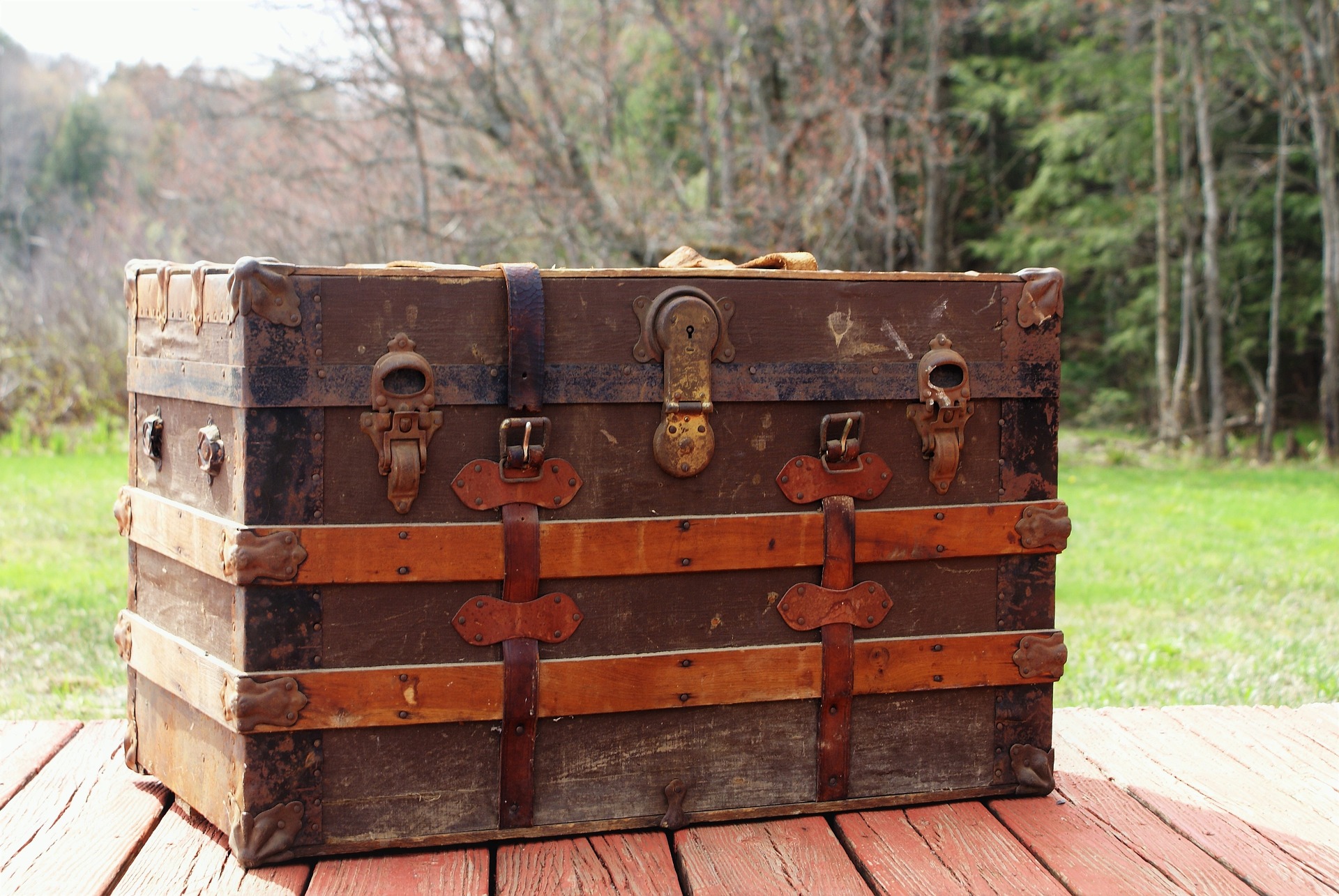
Antique trunks are more than just sturdy containers; they’re time capsules overflowing with stories of journeys undertaken, lives intertwined, and eras past. Restoring one isn’t merely a task; it’s an excavation of history, a chance to breathe new life into a forgotten relic, and ultimately, to create a unique and functional heirloom for generations to come. But where does this captivating adventure begin? Fear not, intrepid explorer, for this in-depth guide will equip you with the knowledge and confidence to navigate the thrilling world of antique trunk restoration.
How to Restore an Antique Trunk:
Preparation and Planning
Before diving headfirst into the restoration process, it’s crucial to chart your course carefully. Here are some essential steps to lay a solid foundation for success:
1. Unearthing the Trunk’s Secrets:
- Identification: Research is paramount. Delve into the trunk’s history, identifying its type, age, and estimated value. Consulting online resources, antique experts, or historical societies can yield valuable insights. Understanding the trunk’s background will guide your restoration choices and ensure you preserve its unique character.
- Condition Assessment: Conduct a thorough inspection, meticulously noting any damage, missing parts, or structural weaknesses. Documenting the condition with photographs will help you track progress and make informed decisions throughout the restoration journey.
2. Gathering the Restoration Tools:
- Essential Tools: Assemble the necessary tools, including screwdrivers, hammers, pliers, clamps, sanding equipment, paintbrushes, and safety gear like gloves, respirators, and goggles. Consider investing in specialized tools for specific tasks, like upholstery staplers or lock picks.
- Material Must-Haves: Stock up on high-quality restoration supplies. Depending on the trunk’s condition and your desired outcome, you might need wood glue, metal polish, cleaning solutions, replacement hardware, various finishes, and decorative elements. Remember, using quality materials ensures a durable and visually stunning restoration.
3. Setting the Restoration Stage
- Workspace: Choose a well-ventilated, spacious area for your restoration project. Ensure proper lighting and ample room to maneuver the trunk and work comfortably. Protecting the surrounding area with drop cloths or tarps is essential to prevent spills and damage.
- Safety First: Safety should always be your top priority. Wear appropriate protective gear when handling chemicals, using power tools, or sanding. Work in a well-ventilated area and familiarize yourself with proper safety protocols for each task involved.
Moving to the next steps:
With your preparation complete, it’s time to embark on the exciting restoration journey itself. Each step unveils a layer of the trunk’s history and brings you closer to its revitalization:
Cleaning the Antique Trunk
The first step in restoring an antique trunk is to clean it thoroughly. This involves removing any dirt, dust, or grime that may have accumulated over the years. Begin by wiping down the exterior of the trunk with a damp cloth. If there are any stains or discolorations, use a mild soap and water solution to gently scrub them away. For stubborn stains, a mixture of vinegar and water can be effective. Here are more specific steps:
- Exterior Cleansing: Gently wipe down the exterior with a damp cloth to remove dust, grime, and cobwebs. For stubborn stains, use a mild soap and water solution, always testing on an inconspicuous area first. Remember, different materials require different cleaning methods. Be gentle with leather, fabric, and delicate finishes.
- Interior Spruce-Up: Vacuum the inside to remove loose debris. Wipe down with a damp cloth, tackling musty odors with baking soda or charcoal briquettes placed inside for a few days.
Repairing Damaged Parts
Antique trunks may have a variety of damage, from broken or missing hardware to cracked or split wood. Before beginning the restoration process, it is important to assess the extent of the damage and make a plan for repair.
- Hardware: Assess any missing or damaged hardware. Seek replacements from antique hardware suppliers, ensuring they match the style and age of your trunk. For minor repairs, consider metal glue or solder.
- Wood Wizardry: For cracked or split wood, use wood glue to carefully mend the pieces, clamp them securely until dry, and sand smooth. Remember, respecting the structural integrity of the trunk is crucial.
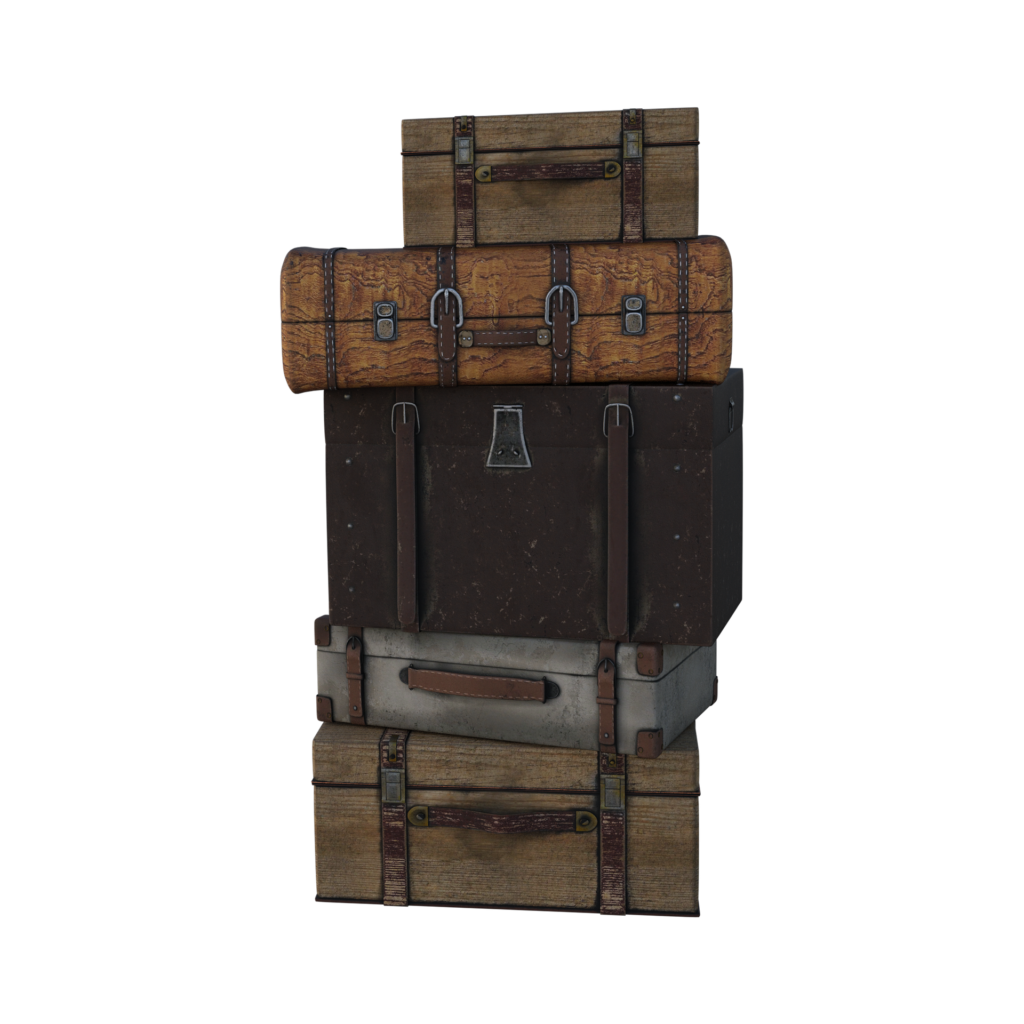
Step 3: Stripping the Trunk
Once the trunk is clean and any damaged parts have been repaired, it is time to strip the old finish. This is an important step in the restoration process, as it allows the new finish to adhere properly to the surface of the trunk.
Begin by using a paint scraper or putty knife to remove any loose paint or varnish. Next, apply a chemical stripper to the surface of the trunk, following the manufacturer’s instructions carefully. Allow the stripper to sit for the recommended amount of time, then use a scraper to remove the old finish.
Step 4: Sanding the Antique Trunk
After the old finish has been stripped away, it is time to sand the trunk. Sanding helps to smooth out any rough patches or imperfections in the wood, and prepares the surface for the new finish.
- Respecting the Grain: Remember, sanding with the grain is crucial to avoid damaging the wood. Take your time and apply gentle pressure, working in small sections to achieve a consistent smoothness.
- Curvaceous Challenges: For curved surfaces or intricate details, consider using sanding sponges or sanding blocks to reach those tricky areas.
- Dust Busters: Regularly clean away sanding dust to prevent it from clogging the sandpaper and hindering your progress. Wear a dust mask to protect yourself from inhaling harmful particles.
Staining the Trunk
Embracing the Wood’s Character (Optional): Staining
- Color Alchemy: Staining enhances the natural beauty of the wood and provides a uniform color, if desired. Choose a stain suitable for the wood type and consider factors like historical accuracy or personal preference. Apply the stain evenly with a brush or cloth, ensuring proper coverage and following the manufacturer’s instructions. Remember, test the stain on an inconspicuous area first.
- Layering for Depth: Experiment with layering different stain colors to achieve a richer, more complex look. Remember, each layer needs to dry completely before applying the next.
- Sealing the Deal: Protect your beautiful stain job with a clear sealant specifically designed for wood. This will prevent fading, water damage, and future stains.
Apply the stain with a brush or cloth, making sure to cover the entire surface of the trunk. Allow the stain to sit for the recommended amount of time, then wipe away any excess with a clean cloth. Be sure to wear gloves and work in a well-ventilated area to avoid inhaling fumes or staining your skin.
Applying a Protective Finish
After the stain has dried, it is time to apply a protective finish to the trunk. There are several options for finishes, including varnish, polyurethane, and shellac. Each type of finish has its own unique properties and benefits. So, it is important to choose the one that is best suited to your specific needs and preferences.
Varnish is a durable and long-lasting finish that provides excellent protection against moisture, heat, and wear. It is available in both clear and tinted varieties. Feel free, to choose the level of sheen and color that best complements your trunk. Varnish is typically applied in thin coats using a brush, with sanding between each coat to ensure a smooth and even finish.
Polyurethane is another popular choice for trunk finishes, as it is extremely tough and resistant to scratches and dents. It is available in a range of sheens, from matte and high gloss. This can be applied with a brush or sprayer. Like varnish, polyurethane should be applied in thin coats, with sanding between each layer to ensure a smooth and even finish.
Shellac is a traditional finish that has been used for centuries, and is still a popular choice for antique trunk restoration. It is easy to apply and dries quickly, providing a beautiful and durable finish that resists moisture and wear. Shellac is available in a range of colors, from clear to amber, and can be applied with a brush or rag.
When applying a finish to your antique trunk, it is important to work in a well-ventilated area and wear protective gloves and a respirator. Follow the manufacturer’s instructions carefully, and apply the finish in thin coats to avoid drips or runs. Allow each coat to dry completely before sanding and applying the next layer.
- Varnish: Durable and long-lasting, offering excellent protection against moisture, heat, and wear. Available in clear and tinted varieties. Apply in thin coats with sanding between each for a smooth, even finish.
- Polyurethane: Extremely tough and resistant to scratches and dents, available in various sheens. Apply with a brush or sprayer, sanding between coats for smoothness.
- Shellac: A traditional finish, easy to apply, offering a beautiful and durable finish. Available in various colors. Apply with a brush or rag.
Replacing Hardware
Once the finish has dried completely, it is time to reattach the hardware to the trunk. Use screws and nails to secure hinges, latches, and handles in place, being careful not to damage the newly finished surface of the trunk.
If any of the hardware is missing or damaged beyond repair, it may be necessary to purchase replacement hardware from a supplier that specializes in antique trunk hardware. Be sure to choose hardware that is appropriate for the style and age of your trunk, and follow the manufacturer’s instructions carefully for installation.
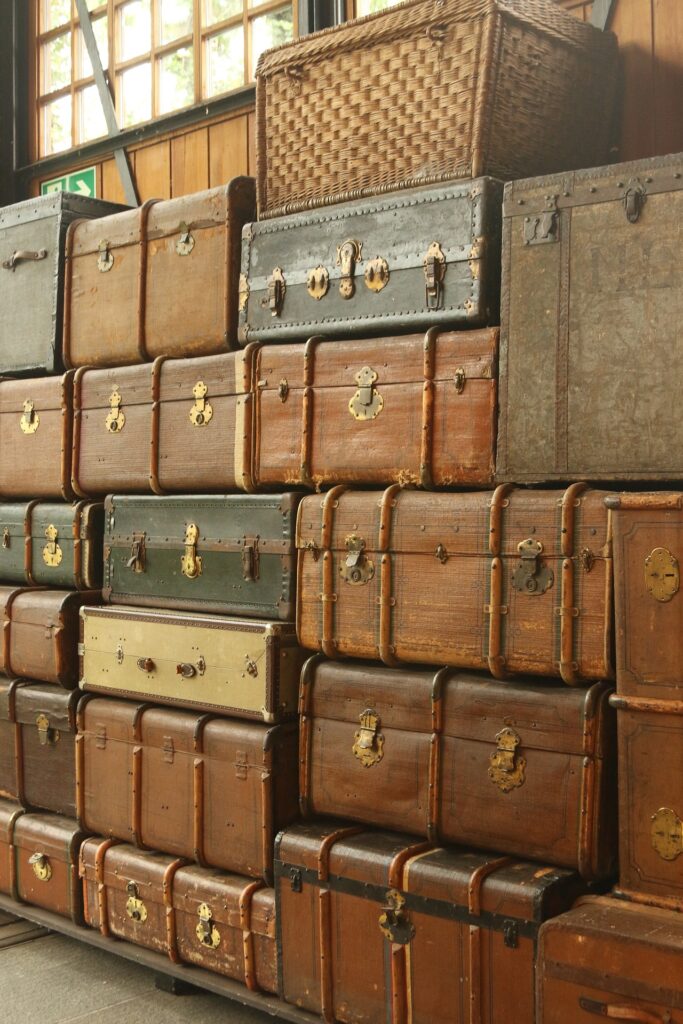
Adding Decorative Elements
If you wish to further enhance the beauty of your antique trunk, consider adding decorative elements such as stenciling or painting. This can be a fun and creative way to personalize your trunk and make it truly unique.
Stenciling can be done using pre-made stencils or by creating your own design. Use a stencil brush and acrylic paint to carefully apply the design to the surface of the trunk, being careful not to smudge or blur the edges.
Painting is another option for adding decorative elements to your trunk. Choose a design that complements the style and age of your trunk, and use acrylic paint and a fine brush to carefully apply the design. Allow the paint to dry completely before applying a protective topcoat.
- Final Flourishes: Buff and polish the finished trunk to reveal its radiant beauty. Stand back and admire your handiwork!
- Caring for Your Heirloom: To preserve your restored treasure, store it in a cool, dry place away from direct sunlight and extreme temperatures. Clean it regularly with gentle methods suitable for the materials used.
Restoring an antique trunk is more than just a project; it’s a journey through history, a testament to human craftsmanship, and an opportunity to create a lasting legacy. Your restored trunk, now imbued with your own dedication and creativity, will continue to whisper stories for generations to come. So, embark on this adventure, embrace the challenges, and revel in the satisfaction of breathing new life into a forgotten treasure. Remember, the journey itself is as rewarding as the destination, and the stories your restored trunk tells are priceless.
About the Author
Wooden Furniture Hub
We understand that there are a lot of questions when you are looking for quality, durable and affordable wooden furniture.
Our furniture feature articles inform and educate so you can make intelligent decisions about wooden furniture, stores, woodworking plans, design and plus size furniture to name a few.
We know life isn’t easy. We just make it easier for people to pick the right furniture and enjoy it for many years to come.
Enjoying our content? Please share!
- How to Paint Metal Patio Furniture
- Top Trends in Outdoor Patio Furniture
- Where To Buy Replacement Vinyl Straps for Patio Furniture
- Mastering the Art of Furniture Consignment
- Oshields Upholstered Chaise Lounge
- Transform your Outdoor Space with Stylish Patio Furniture: A Complete Guide
- The TOP High-End Bathroom Vanity Brands in 2024
- How to Mow a Lawn Properly: A Comprehensive Guide
- How to Replace Vinyl Straps on Patio Chairs: Step-by-Step Guide
- How to Paint Outdoor Metal Furniture Like a Pro!
Top 10 Eco Friendly Home Products to Consider in 2023
Shop smart. start here..
- Privacy Policy
- What’s Trending
- Outdoor Furniture
- Plus Size Furniture
- Furniture Stores Reviews
- Product Reviews
- Design Ideas
You may also like these

How To Decorate A Bedroom With Cherry Wood Furniture
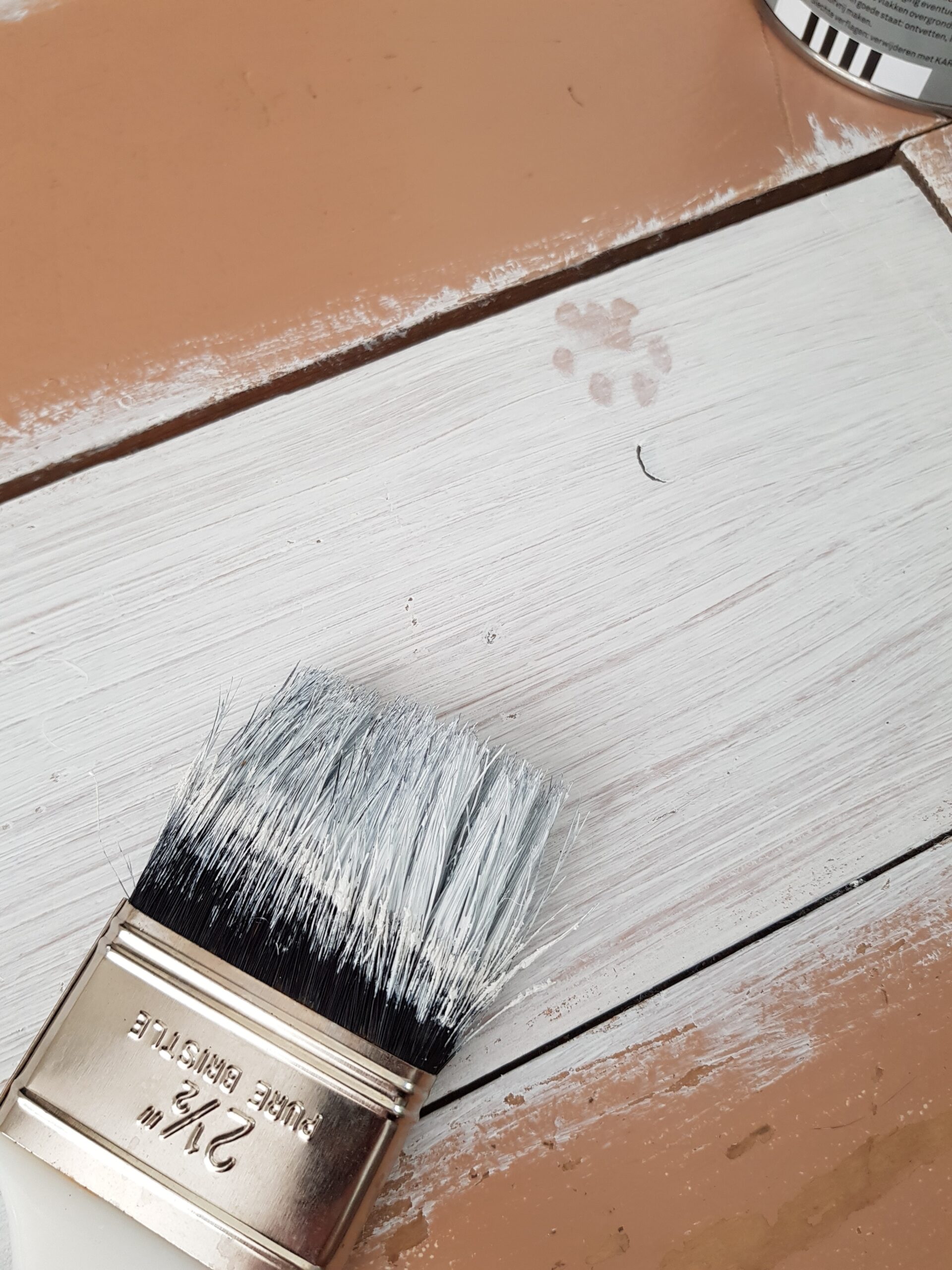
Wooden Furniture Paint

5 Stylish Wooden Christmas Decorations

The social platform for antiquers, collectors, and enthusiasts
Editorial Archives
- Read Current Issue
- Editorial Extras
- Map to Show Fields
- Show Field Schedule
- Seen Around Brimfield
- Read Current Brimfield Guide
- Post-press Updates
- Marketplace News
- Digital Publications
- Collector Clubs
- Marketplace Exchange
- Shop Finder Directory
Exploring Antique Technologies
One hundred years of american trunk innovation.

By Paul Norton
Trunks and travel articles tell a story of adventure and intrigue. The impulse to travel—into town or overseas—required bringing along one’s necessities. As 18th and 19th century travel evolved from the horse, stagecoach, and boat to train, clipper ship, and the appearance of the ocean liner, changes in the style, size, and material used in the making of bags, satchels, and travel trunks were adjusted to best suit travelers and their belongings.
The American Travel Trunk
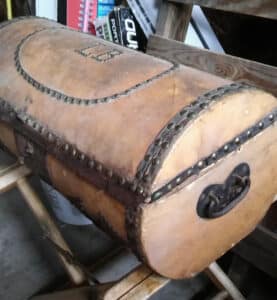
The American travel trunk began as a smaller saddle trunk shaped like a bedroll. This would be strapped to the saddle carrying just enough for overnight trips when traveling by horse. Most late-18th century saddle trunks were manufactured by military garb, saddle, and harness makers. Any decoration was minimal with a simple printed label inside with the maker’s name and location. Measuring about 7 to 10 inches in diameter, the sizes were regulated, as the story goes, not to impede passage.
Early 19th century trunks evolved into larger, round carriage or wagon trunks about 10-14 inches in diameter. The larger examples did have some decoration on the exterior as makers customized the trunks using 3/8 to 1/2 inch brass tacks holding down a fancy trim surrounding the owner’s monogrammed initials. Steel tacks used along the wood frame held down a hide cover commonly made of rough cow, pony, deer, and hair-on. Calfskin was more refined.
Evolving Trunk Dimensions and Structure
The 1830s-style trunks took on a boxier shape with a gently arched top to provide more storage for open wagon travel. They had the added benefit of providing a handy seat. Some had a “pass-through” compartment under the heavy leather lid where clothing could be placed to take advantage of the added domed space.
Wood frames were hand-planed pine and poplar, native to New England. Handles were typically made from leather or wrought pig iron, the bases had flat steel cut in the shape of hearts.
Interior home use chests shared the same hand-wrought lock and hasp sets and handle designs mostly with dovetailed construction. The decoration used for the lining differed to suit the owner. Home use trunks had a fancy painted or graining to the exterior. By the 1840s, larger travel articles were required. Hair or hide trunks were falling out of favor with leisure users.
Larger size trunks always ran the risk of damage. Imagine a Concord stagecoach being loaded on the top rack with heavy baggage. As better wagons were built, strong front-to-back straps originally used on saddle trunks reappeared to secure the trunk to the rack. Still, the trunk sizes increased, ranging to over 30 inches across and 18 inches high, yet were limited somewhat due to the size of the carriage rack space made to typically hold two trunks across.
A Touch of Style
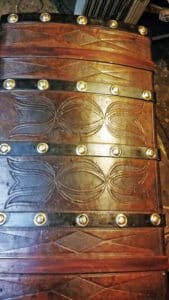
Both changes to fashion and an increase in travel dictated a finer level of finish and materials. More finished leather—sometimes painted black, green, or red—was tooled with pinwheel or geometric folky patterns. Most importantly, the rolled steel banding or strapping now covered edges and middles, held in place with larger more decorative brass buttons sized 5/8 to 1 inch. More expensive trunks had rolled brass over the iron straps. Clinch nails were cinched on the insides before the interior finish was applied. Sometimes wagon trunks are found with sewing through the wood frame showing off harness makers’ work.
Locks & Hardware
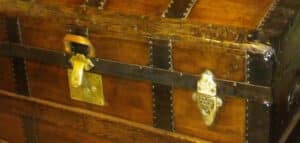
Most locks made up until 1820 were English made and stamped with “Patent” or a stylized crown. American-made blackened iron locks emerged during the 1830s, with a small escutcheon or leather flap to keep dirt and elements out. A decade later, the refinement of brass supplied the market with cast lock plates. New designs for trick keyhole covers included mythical animals, figureheads, dolphin tails, and lion designs among others accented for higher grade trunks. Predominant trunk lock makers of the day were Eagle Lock in Terryville, Connecticut, and Star Lock in Philadelphia.
Customization
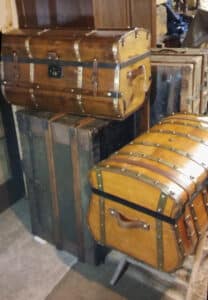
Wealthier patrons wanted function, design, and most importantly individuality. Jenny Lind “hourglass” shapes were similar to a keyhole or loaf of bread viewed from the side, commonly 26 to 30 inches across. Jenny carriage trunks were named after the famous European opera star Jenny Lind. She arrived in America in 1850 and toured extensively for PT Barnum.
Patent trunks became popular during the 1850s because of the increased use of patented hardware available to trunk makers from private firms. Various companies used similar corner wheels, hinges, corners, and handle ends required on large trunks.
The Next Level
With the change in travel destinations from carriage and rail to ocean travel for completing a “Grand Tour,” boxier and smaller carriage trunks gave way to a dome top design popular until about 1890. Also referred to as barrel tops and camelbacks, these larger travel trunks were designed with metal hardware trim to protect the trunk’s contents from damage. During the 1900s, Connecticut makers such as Stanley Works in New Britain, Eagle in Terryville, Corbin in New Britain, and Yale in Stamford, provided the hardware and locks for this next generation of larger and more durable and ornate travel trunks, including The Saratoga.
The Saratoga
Starting around 1850, elite New Yorkers and those traveling through New England came to the Saratoga’s Spa City in upstate New York by train and carriage for a weekend or arrived to stay for “the season.” An entire summer away from home meant hauling a whole summer wardrobe. And in the days before shorts and slip dresses, 19th century vacationers needed some serious luggage. Fashionable balls and overnight stays required day and night outfits with separate hats for both men and women. Ladies were required to travel with countless hats and gowns. Never mind the myriad of undergarments required. The grand Saratoga trunk, synonymous with high quality, met that need.
Saratoga trunks started out smaller in size for transport by carriage. During the 1860s, with the expansion of more direct railroad service, sturdy and elaborate custom interiors were designed to hold the latest fashionable dresses and personal effects. These popular trunks were spectacular on the outside with their dome tops, leather straps, custom locks, and collapsible handles that also allowed for easier handling and stacking. On the inside, personalization and beauty collided with linen or cloth linings and personal touches such as wooden compartments to hold hoop skirts, corsets, and other required outfits, and safe places to store valuables. Papers, calling cards, and letters sent and received at destination stops along the journey were typically affixed to the upper compartment lid in a letter pouch or with French crisscrossed cloth binding. One myth tells that dome tops were developed because wealthy baggage owners wanted an unstackable type on the top of the pile for easy retrieval. Domes were fancier and held various compartments easily.

Traveling into the 20th Century
In the lead-up to the Victorian heyday, rail and ship travel became more popular. During the second half of the 19th century, demand increased for custom-made, functional, sturdy trunks designed to meet the needs of the wealthy traveler away for an extended stay.
Durability was key. Freight companies handling baggage to and from travel points and the stacking of trunks for transport could easily result in cave-ins and damage to lighter grade trunks. Imagine three or four levels of loaded trunks stacked in a ship’s hold or a railroad baggage car. American travelers were on the move and needed their belongings to arrive safely. Updated designs included cast lid levelers and heavier closures and locks to prevent lids from opening. Rivets put through the wood frame to hold hardware on is a sure sign of an overbuilt trunk. Later, Sample quality types used as many as 300 rivets for a single trunk.
Well-made custom trunks were considered a display of status and success. Packing space for the latest fashions saw interiors become lighter with carded tray covers decorated in flashy colors with stamped and gilded trim. Linen rather than a basic paper lining was more desirable and finely completed by accomplished craftsmen.
A standard layout included a long narrow compartment towards the back of the tray for a cane or parasol and a removable, typically 10 x 12-inch hatbox to keep the hat fresh and accessible for the local rides to the final destination.
Customers could provide trunk makers with illustrations they wanted to use to decorate their trunks. Trade Cards, Currier and Ives, and hand-colored Godey fashion prints were popular. Selected from a book of trunk prints, images of sleigh and wagon rides with nostalgic pastoral scenes could also grace interiors. Historically, this practice began during the 1840s with stenciled silhouettes of loved ones applied to interiors. By the 1850s, stencil work was being replaced due to the advent of photography. Studios honed their craft towards providing customers with decorative cutouts of intricate designs applied to Jenny interiors on either side of the letter pouch. Popular colors included purple, red, pink, and lime green.
Legacy Trunks
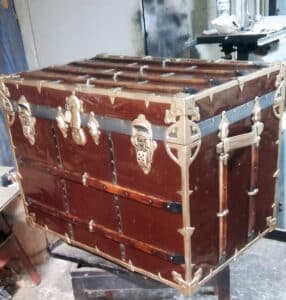
By the turn of the century, makers, and trunk firms that began in the 1840s, were developing new materials. Design changes were once again influenced by changes in fashion – this time in ladies’ hats, to accommodate the larger Edwardian hat. Ladies required a flat boxy carrier for multiple hats.
Trunk makers also began offering commercial-grade sample trunks with fitted cases and canvas coverings; circus and theater-quality trunks that could withstand rigorous and continual use. Companies began branding their products and locks with custom in-house hardware to take advantage of this interest in high-end, custom trunks.
Trunks for All
Some personal use travelers were looking for lighter items with less reliance on freight companies. Steamship liner travel saw immigrant, steerage, and third-class travelers reusing out-of-fashion trunks from an earlier time.
Most American trunks made after 1900 were low grade and inexpensive, catering to a more economical and student traveler; however, the heaviest Sample grade trunks were used primarily by salesmen for various product demonstrations well into the 20th Century.
Today, finding, restoring, and repurposing vintage travel trunks is popular and fun. Before getting started, learn to recognize a heavier grade candidate for restoration.
Paul is celebrating 40 years in the antiques trade. He started out by salvaging a family trunk when he was 9 years old, and today collects Sample trunks and overbuilt industrial age examples made from 1880 to 1910 made by east coast legacy trunk firms including Crouch and Fitzgerald, H C Faber, and Letheroid. He recently supplied over 30 19th century trunks to an HBO miniseries. Paul specializes in trunk hardware and locks and restoring trunks for himself and the public. To contact Paul, you can phone and text him at 860-402-4791 or email [email protected]

Related posts:
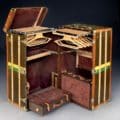
We are a national, special interest magazine and social platform providing “dealers, collectors, and enthusiasts of antiques and collectibles” curated original and aggregated content, editorial opinions, marketplace news, auction results, and resource directories.
Categories of Interest
Gavels 'N' Paddles
Antiques Peek
Great Collections
Collector's Lane
Toys From The Attic
Video Gallery

- Privacy Policy
©2024 The Journal of Antiques and Collectibles
- Assign a menu in Theme Options > Menus
Want more Journal of Antiques & Collectibles articles and marketplace news delivered directly to your Inbox? Sign up to receive our FREE bi-monthly e-newsletter, Post-Press Update, for information of interest to buyers, showgoers, antiquers, and collectors of antique collectibles. Sign up here:
Restoring a Vintage Steamer Trunk

Introduction: Restoring a Vintage Steamer Trunk

Trunk restoration is a combination of wood working, metal craft and leather work, so it helps to have some experience in all three fields. The hardest part of the entire project is in the preparation of the piece. Removing the old material covering (if it has one), stripping the paper lining and removing all of the old leather accoutrements equals roughly 60% of the work that goes into it, with leather fabrication and sanding taking up the rest. There are three approaches you can take when performing your restoration; The first is a complete refurbish with new materials which ends with a fantastic finish, but can seriously diminish the value of your antique. The second is a 'soft' restoration, where no new hardware is used, and only what was used in the original construction goes back into it's rebuild. This kind of project is best used on pieces of extreme value, where authenticity is important, but can seriously limit the 'curb appeal' of your trunk. The third is a moderate restoration, where as much of the original hardware is re-used. Whenever possible, parts from the same period (and preferably manufacturer) are installed and failing that, replaced with new hardware. I find the third method the most effective since it retains both curb appeal, and attempts to keep the piece as original as possible, however, feel free to use whichever one suits you best.
Step 1: Tools and Supplies You're Going to Need
Tools: Utility knife - for removing old canvas cover. (have lots of extra blades since the years worth of dirt in the material act like sandpaper) Metal Scraper - scraping off old paper, tucking edges of old material under seams Drill and Wire Wheel - For removing rust from metal parts Nail puller and hammer - removing old hardware Sharp Chisel - to straighten the points on the old nails and tacks before pulling Pliers - for straightening nails and tacks Sander - optional but it helps Dust Mask and Glasses - Safety first **Saw - if you need to build a new tray otherwise it's not necessary Supplies: 60, 150, 220, 300 and grit sandpaper - lots of that to be done 7-8oz leather @ 1 1/4" leather belts - For straps, leather patches and leather handles 2X Belt Buckles, rivets , Fiebings leather dye - hardware for leatherwork. Wood Stain/Finish - I used Minwax Polyshades which blends both stain and polyurethane but you can do them separately if you want. Masking Tape - to mask of edges for staining Beeswax Polish - to protect the metal from rusting again
Step 2: Disassembling Your Trunk

One of the trickiest parts of the project is disassembling the trunk. The first place to start is to remove the lid and leather hardware. Most of it should be held together by tacks and nails that punch through the wood and have their points bent down on the inside to hold them in place. This is where the sharp chisel comes into play. You want to be as careful as possible, since if you simply use the nail puller, they'll just tear through the wood leaving gaping holes that will require filler. Your best bet is to get under the point, on the inside of the box, as carefully as possible, then use your pliers to straighten the tips as best as you can. Then you can use the nail puller, from the outside, and yank the old tacks out. If they aren't rotted to badly, they can be taken to a wire wheel to be revived, otherwise they'll need to be replaced. The rest of the hardware, such as, the metal trim and hinges can be removed in the same way, but as you'll see later, it can be better to leave them on.

Step 3: Cleaning Up the Metal

To keep the trunk as original as possible, I wanted to leave as much of the patina on the metal as I could. The best way I found was using a wire brush on the end of a drill to buff off the layer of rust, but leave the pitting and age behind. Originally I tried a brass brush, which is less abrasive, but found it left marks on the metal work, so I ended up using the steel one and found it worked perfectly. Another advantage of the wire wheel is the ability to get into all of the nooks and crannies around the hardware. The trick is not to press to hard as you don't want to polish the metal, only remove the outer layer of rust exposing the darkened aged metal underneath. Another thing I learned was that it was better to leave the canvas cover on the trunk as I was removing the rust since it protected the wood, and I would be removing it anyway. I wasn't terribly concerned about the paper edging since I would be sanding it later to remove some of the staining and age, and also clean some of the rivets that pin them in place.
Step 4: Removing the Canvas Cover, Paper Liner and Sanding

Exposing the bare wood; The liner should come out pretty easy, and for the most part just peels away from the wood. In the original construction, they used a paste of flour and water as a glue which is water soluble. A few spots were still stuck fast, so I simply soaked them with a damp sponge, and scraped them. The canvas was a bit trickier to remove. I used the utility knife and cut the cloth as close to the seams as possible, cutting around some of the metal work. When the bulk of the canvas was removed, I used the scraper to tuck any remainders under the seams and the utility knife to cut off the fibers that straggled behind. For the tight corners, a slotted screwdriver or chisel works just as well. Sanding; There's going to be lots of that. The best way is a graduated sanding where you start with 60 grit, to remove some of the larger burrs, then gradually reduce the grit to 300 until the piece is nice and smooth. For the paper edging, start with 220, then 300, unless it is badly damaged, then you can use 150. The paper is set in layers, so if you remove one layer completely, you'll need to keep sanding till you get down to the next one which will make lots of extra work for you. Try not to sand to heavily on the tacks holding the paper in place as you want to keep the same patina as the rest of the metal hardware. You can wet sand with 400 grit, but I found it unnecessary since 300 seemed to do the trick. The Inside; The inside should be thoroughly washed with bleach and water to kill any mildew, then let to dry before sanding. Sand it very thoroughly since you won't be lining it again with paper (unless you really want to). I found it looked better without, however if you choose to, comparable paper can be found in any art store.
Step 5: Staining and Finishing

I used combination of walnut stain with polyurethane however if you choose, you can apply them independently. I applied three layers with a soft brush, and made sure to mask off the paper edging. There's no need to stain the inside of the trunk and in fact, the raw wood look made a nice contrast. Once the stain/finish had dried overnight, I then used the beeswax polish and applied three coats on both the outside and inside of the trunk, wiping off the excess between coats. The polish reconditions the wood and paper edging, as well as protecting all of the metal work from rusting again.
Step 6: Building the Tray

If you're fortunate, you will still have the old tray that can be restored in the same way as the rest of the trunk. Unfortunately, the tray in my trunk had completely deteriorated and so I had to build a new one. I used the old tray as a template and cut a piece of 1/8" plywood for the bottom, and some 1x4" pine for the sides. The picture below shows the tray before the beeswax coat, however I used the same three coats as I used on the rest of the trunk to protect it. Finally, I cut a two 3 1/2" x 3/4" pieces of leather to act as handles for the tray then set them into place with 1" brass tacks.
Step 7: Adding the Leather Work

Now you have a choice, you can stop here and leave the leather work off, or you can replace it all, or if you're really lucky, the existing leather survived and you can use it again. If you choose to replace it all, you'll need enough 7-8oz leather to cut your strap holders and handles from, and enough leather to create the straps. The original straps were actually made of several 6 foot belts that were riveted together to make 12 foot lengths. Unfortunately, I couldn't recover any of the original leather so I decided to customize it with my own color and design. I performed a bit of tooling on the strap holders, but it's not necessary if you prefer to keep them plain. I was also unable to save any of the original tacks and nails, so I replaced them with brass rivets which were long enough to push through the wood, and have the tips bent down like the original hardware. I used one of the original strap holders as a template for the new ones and was able to set the tacks through the existing holes from the old nails for a cleaner look.
Step 8: Finished Trunk and Key Replacement

The trunk is complete, and as original as was possible to make it with my limited resources. The last thing it needed was a new key for the lock. I found the name "Corbin" etched into the lock, and tracked a few possible replacements at the local Flea market. With a bit of work I managed to fabricate a new one by locating a key with as much metal on it as possible, then dremmeling it down till it spun the lock. It's pretty tricky to do if you don't know what the original looked like, but there are a few tips I can give you; 1. Get more than one key. You WILL mess up at least one, so have a few extras 2. Learn how to pick the lock first. There are tutorials online that will teach you and it'll give you an idea of the shape you need. 3. As the key gets closer to the right shape, it'll slowly turn the lock more and more. Maybe it's a design flaw with these old locks, but the closer a key is to being right, the more movement you'll get out of the lock. 4. Once you get it to turn, stop using power tools and break out the hand files. You only want to work it until it starts turning the lock smoothly. That's it! Hope you have as much fun with your project as I did.
Recommendations

Making Time Contest

Engineering in the Kitchen - Autodesk Design & Make - Student Contest

All Things Pi Contest

- Cart: 0
WARDROBE TRUNK CONVERSIONS
Since we began restoring antique trunks (and every other style of old trunk), we have always been proud of the work we've done on wardrobe trunks. If you have had a look at the pages of this website, chances are you have seen examples of some of the restorations and conversions that we have performed on various large and small antique wardrobe trunks. What differentiates a wardrobe trunk from any other trunk is that it will usually have drawers, hangers and other storage compartments not normally found in a typical "travel trunk". It also is designed to 'stand up' rather than be laid down on the side, for obvious reasons.
This 'standing up' design lends itself to a number of creative changes, or conversions . One of the most popular redesigns for a wardrobe trunk is to convert it into a bar. That's right...a bar! We've converted dozens of these antique trunks into bars and, while they are time consuming to restore this way, the end result can be incredible. Not only does this kind of project produce a beautiful and useful piece of furniture once complete, it can be designed to fit in with any sort of decor imaginable. Now this is where the fun begins!
If you have an old wardrobe trunk that you would like to have converted into a bar, call us! There are numerous, rather ENDLESS possibilities and we are here to consult with you on what works best, how much it will cost and how long it will take to achieve exactly what you would like. Want an interior design that is rich with leather and mirrors? That's an easy one! What are the primary colors of the room in which your newly converted trunk will be in your home? Want it to have lots of extra storage cabinets and drawers? Just imagine that musty old trunk that has been in your family forever, being reborn with the colors that will work in your home and it being FRESH, FREE OF MOLD, CLEAN and now a striking centerpiece that will be able to be passed down for generations to come.
It's not just all about "Bar Trunk" conversions either. Most wardrobe trunks were built with an efficient design...a traveling 'closet', if you will. Lots of drawers, an area to hang your clothes on hangers, boxes for your shoes and a zillion other compartments for storing and transporting your wearing needs. Most people need extra storage space for clothing and nothing works better than being able to stand up a beautifully restored antique wardrobe trunk and load it with your favorite clothing and accessories. The best part is that it doesn't take up a lot of space and can be easily positioned in just about any room. We're finding that more and more people want to have their wardrobe trunk utilized as a display in the home and with good reason. Hang an elegant antique dress or suit within, drape a few scarves from the drawers and you've got the beginning of a virtual movie set within your home! Maybe you'd like to have the drawers reconfigured to accommodate your collection of shoes, what a great idea, and we can do that for you! Having your wardrobe antique trunk converted into a useful piece of furniture is as practical as it is exciting and it's really up to you just how simple, or radical, you want the change to be. The below photos are samples of some of the antique wardrobe trunks that we've restored and converted and any of the elements that you see incorporated into these can be fitted into your trunk. We have also performed restorations on a good many Louis Vuitton wardrobe trunks, large and small. We are able to perfectly match color, design and, in most cases, hardware to maintain the historical accuracy of each piece.
One of the challenges presented by most wardrobe trunks is mold. Bad stuff it is, and it can render your antique trunk unusable; because of the incredibly horrible odor that accompanies it. Wardrobe trunks in particular, have been cursed with mold and there is an obvious reason why. Imagine after each wearing, you put your clothes back into a drawer and then have the clothes sit in that same space during your entire trip. AND THEN! your wardrobe trunk gets stored in the deep holds of steamer ship for a week. After about 50 years (or so..) of doing this, your trunk is going to act like a sponge for odors, dirt, mold and more. Much easier to air out a standard 'box' trunk, a wardrobe trunk has all sorts of nooks and crannies for these evil bacteria to hide and fester..YIKES! So when we take delivery of a wardrobe trunk for a conversion or restoration, the first thing we do is open it up and get it into the sun as fast as possible. The hot California sun that we enjoy is one of the best killers of mold and we are lucky to have such an ally! After a few days of being blasted by the sun, we then reach into our arsenal of mold killing agents and hit it hard. More sun, then more cleaning and dosing with these agents does the trick.
AND..it is not just all about the interior that we can restore. Over the years, we have perfected a way to restore the EXTERIOR surfaces of an antique trunk too. The below photos show some examples of our technique, in the finished state.
As you can see, we've refinished just about all of these exterior surfaces back to a near new condition. What we haven't shown are pictures of exteriors that we've pretty much left alone to retain original character. Lots of times there will be travel stickers plastered all over an exterior and these can be part of the charm of the piece. So we work around them. Or remove them and then place them back, exactly as they were before. For a nominal fee, we can also recover the entire antique trunk in leather, if you want, or make it any color that you want.
It is also interesting to note that wardrobe trunks were considerably more expensive than regular trunks when new. Makes sense. More compartments, more features, much more elaborate design makes for a higher retail price. Lets take a look at the photos above with all the wardrobe trunks closed up. The RED one on the bottom left side, when new, was in the range of $200 back when it first hit the stores, brand-spankin' new. In TODAY's dollars, that would be around FIVE THOUSAND DOLLARS! How about a less elaborate antique trunk from that grouping....the black one, directly above it, in today's dollars would have cost approx. two thousand dollars, back then? $89.00. Isn't inflation grand?! Now think about having YOUR trunk restored and having it last for the next SEVERAL HUNDRED YEARS! Restoration is a great value using any calculation!
We welcome the opportunity to work on your wardrobe trunk and would be more than happy to give you an estimate for the project before you commit. First sending us detailed photos of your trunk, inside and out, is the way to let us know that you are serious about wanting to have your antique wardrobe trunk converted into a one-of-a-kind masterpiece that will last through many generations. If you intend to give your trunk to someone, particularly a family member, there is no better way to preserve the family legacy. So TODAY is the day to get this project underway! The longer that your trunk sits in your basement, or garage or attic, means less time that you will have to be able to enjoy it. Get in touch with the experts on how to restore antique wardrobe trunks right now! 760 699-8156
- Antique Trunk Restoration Service
- Louis Vuitton Restorations
- Terms & Conditions
- Skip to content
Amish Handcrafted
Real Wood. Fine Craftsmanship.
Unpacking What is a Steamer Trunk: Its History, Uses, Styles, & Modern Appeal
Tips and Tricks / May 19, 2021 by Chris Stoltzfus / 3 Comments

150 Years Ago, You Probably Would Have Owned One

Imagine you were a distinguished gentleman or poised lady from the early 1900s. [Yes, you were likely wearing either a suit and tie or a fur coat and fancy hat. You know back in those kinds of days].
In preparation for traveling, you carefully selected your finest clothing, your hats, and your other personal belongings.
Where did you store all these important items? In none other than… a steamer trunk.
Steamer trunks are fascinating and stunning pieces of traveling, history-filled boxes.
In fact, did you know how steamer trunks played an important role in the history of the Titanic? Or do you know which steamer trunk’s manufacturer is still going strong over 150 years later?
Get Ready to Unpack this Historic Trunk!
Whatever the reason leading you to wonder, “What is a steamer trunk?” Get ready to completely unpack this trunk with its following definition, history, fascinating facts, tips for finding keepers, and much more!
So, What Exactly is a Steamer Trunk?

Imagine this next scene. With your freshly packed steamer trunk safely stowed away in the back of a Renault Type CB Coupe Deville , you head off to the dock to board a ship for your trip across the Atlantic. As you approach the dock, your mouth drops open in awe at the sight of your ticket across the ocean.
The ship you are about to board [along with your steamer trunk] is none other than the majestic, steam-powered Titanic.

So, what exactly is a steamer trunk ?
A steamer trunk is a square or domed shaped storage box used for packing clothing and other personal belongings for travel. The box got coined with the name steamer trunk thanks to its use aboard steam powered ships.
Yes, steam powered ships like the Titanic, RMS Carpathia, RMS Queen Elizabeth, and SS Bremen. However, the first steamer trunks were more likely to be aboard the 1870 RMS Oceanic .

These first steamer trunks were probably no larger than 14 inches tall due to luggage regulations aboard the steam ships. So unfortunately, in the early days of the steamer trunk, unless you were wealthy, most people were limited to packing one or two clothing sets and any other important items that could fit inside the small box.
Often people were migrating across the country or to America and that was all they could bring along.
However, these steamer trunks grew over time and became more intricate and much larger in size and storage capability.
Now back to your imagination .
It is likely that the steamer trunk you used to pack your clothing and personal belongings, was 2 or 3 times the size with small compartments and drawers for luxury items such as jewelry or watches.
Now let’s dig a little deeper into fascinating history of the steamer trunk.
A Brief, Yet Intriguing History of this “Cabin Trunk”

Trunks may be well over a thousand years old. However, steamer trunks took over the luggage scene around the late 19 th century (1870s). Only about 150 years ago.
It was around this time that traveling exploded as railroads and steam-powered boats provided easier and more affordable options for travel.
Steamer trunks popularity lasted for about 55 years until finally losing the luggage spotlight in the early 20 th century (1920s). Yeah, modern luggage, otherwise known as the suitcase, became a lighter traveling companion.
The first manufactures of these cabin trunks [a nickname earned from traveling on boats😊] crafted these boxes out of wood, such as pine. Some steamer trunks could weigh up to 100 pounds alone!
They were often covered with animal hide, plain or decorative tin , paper, canvas, and held together with a variety of hardware or wood slats.
These Traveling Trunks Kept Moving “Full Steam Ahead!”

From such humble beginnings, these trunks continued “full steam ahead” until they were crafted with more than just wood and paper, but expensive cloth materials, leathers, aluminum, and fancy hardware.
Do you recognize the name or brand, Louis Vuitton ?
He was one among many steamer trunk manufactures spread across Europe and America back in the late 18 th century. However, Louis Vuitton remains one of the few original manufactures still going strong today. Among others still in business today are Seward Trunk, Rhino Trunk & Case, and C & C Footlockers.
Check out the super fascinating and short history of this luxury Louis Vuitton brand of steamer trunks. Plus, in the process learn more about the use and history of steamer trunks and their progression with the technological advancements of travel.
Steamer Trunks Still Hold a Sacred Space in Many Hearts & Homes

While the modern-day suitcase is often what you see pulled behind frantic legs in the airports and train stations across the world today, just remember that the steamer trunk once held this esteemed position.
Nowadays, antique steamer trunks are a highly sought-after find in thrift stores or antique shops. You will often find these “resting travelers” adorning the center of a living room or set in the corner of a dining room or bedroom.

While they may have retired from traveling the world, steamer trunks still hold a prized space in homes all over the globe. Their history still making waves which will only grow stronger as time progresses.
In fact, check out the following fascinating fact about the steamer trunk that you probably did not know.
A Fascinating Steamer Trunk Fact You Probably Did Not Know

Let’s go back to our imaginary scene. Your steamer trunk has been delivered to your first-class room aboard the awe-inspiring Titanic. Finally, you crossed the plank and have boarded the floating wonder yourself.
Fast forward. Less than a week later, the unthinkable happened. The Wonder of the steam-powered ship world hit an iceberg. The unsinkable ship began to sink. Thankfully, you were lucky enough to board a lifeboat.
However, your steamer trunk full of your clothing, personal belongings, and important documents and letters, remained aboard the ship as it slipped underneath the icy still North Atlantic Ocean.
How A Steamer Trunk Preserved History!
Which brings us to the fascinating fact you probably did not know.
FACT : Steamer trunks were recovered from the wreckage of the Titanic and documents were found intact inside their oxygen starved compartments .
Are not steamer trunks extremely cool pieces of historical luggage?
Let’s move on to look at some of steamer trunk’s styles from the past and present!
Popular Styles of the Past & Present

You may have heard the saying, “Some things never change.”
Well, in the case of steamer trunk’s styles, the popular styles of the past stuck, and usually can be found as antiques, second hand, or sold brand new.
Steamer trunks styles were often distinguished by the shape of their tops and exterior touches. The following are the top 2 most popular styles of the past and the present.
1. Dome Top

The dome top style is the most attractive style of steamer trunks. These trunks were heavier sometimes weighing 100 pounds alone.
This style offered 3 main advantages.
- Its domed top allowed for extra storage space.
- Also, during travel on open carriages, the curved top helped keep rain from pooling, thus helping prevent water damage. Plus, the fact that these domed shaped trunks could not be stacked, forced porters to store them at the ends or at the top of the piles of trunks instead of underneath them all. This helped keep them from damage.
- Lastly, the dome style steamer trunk offered a unique and elegant appeal with its curved top and embossed tin commonly added to the exterior of these trunks.
In a nutshell, the purpose of the dome style was for its beauty and to prevent damage during travel.
Often when looking for antique steamer trunks, the dome top style is not the most common antique, but often the most popular choice of buyers on the market.
2. Flat Lid
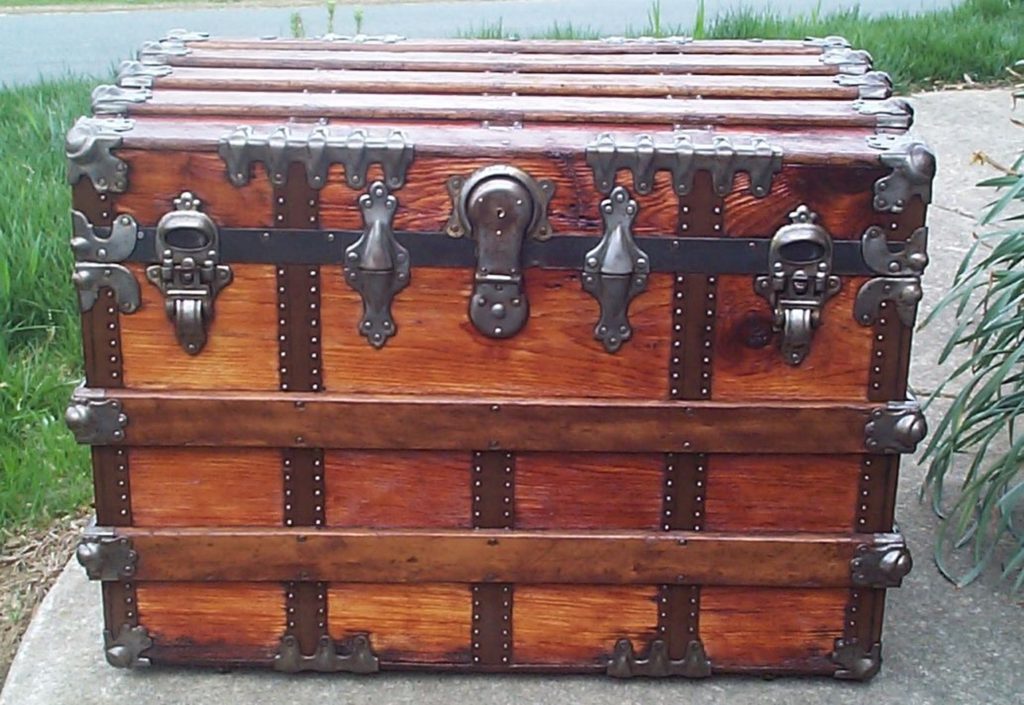
Photo Credit: www.thepirateslair.com
The flat lid of steamer trunks was certainly the most common and the simplest style. Flat topped steamer trunks were designed with one purpose in mind and held one outstanding advantage.
- Perfect for travel! Thanks to its flat lid, these steamer trunks could be more easily packed (or stacked) into the available luggage space of any stagecoach, train, or steamship.
Although, often simpler in design, collectors still love the versatility of use offered by a flat lid steamer trunk. Plus, one of the most sought-after antique steamer trunks, a Louis Vuitton, prioritizes the flat lid style over dome top style for most of their luxury line of steamer trunks.
Whether you favor the dome top or the flat lid, both styles offer a charming twist and hold history rich beauty.
Tips on Finding a Keeper or Money-Making Antique Steamer Trunk

Photo Credit: www.pinterest.com
Are you currently on the hunt for an antique steamer trunk of your very own? If so, enjoy listening to the following 5 tips offered by Dr. Lori, a PHD Antique Appraiser, on how to identify a steamer trunk worth taking home.
5 Tips on Antique Trunks and Boxes by Dr. Lori
For another source on identifying worthwhile steamer trunk finds, check out Antique Trunk Value .
While the value of different steamer trunks can be harder to trace due to their lack of identifying manufacturer tags, if you ever see the following steamer trunk in a thrift store, BUY IT!

Photo Credit: www.la-malle-en-coin.com
An antique Louis Vuitton steamer trunk sells anywhere from $5,000 to $20,000+!
What Makes an Authentic Steamer Trunk?
It is important to note that the word steamer is sometimes a bit misused when it comes to identifying trunks. In fact, nowadays, a wide variety of trunks get meshed into the steamer trunk category.
However, going back to the beginning of its creation, a truly authentic steamer trunk was a wooden traveling box no more than 14 inches high. The length varied and would often be influenced by the luggage size limit imposed by the different steamships and/or by whether you traveled 1 st , 2 nd, or 3 rd class.
Now onward to discovering the trending uses for these resting travelers!
Trending Uses for These Resting Travelers
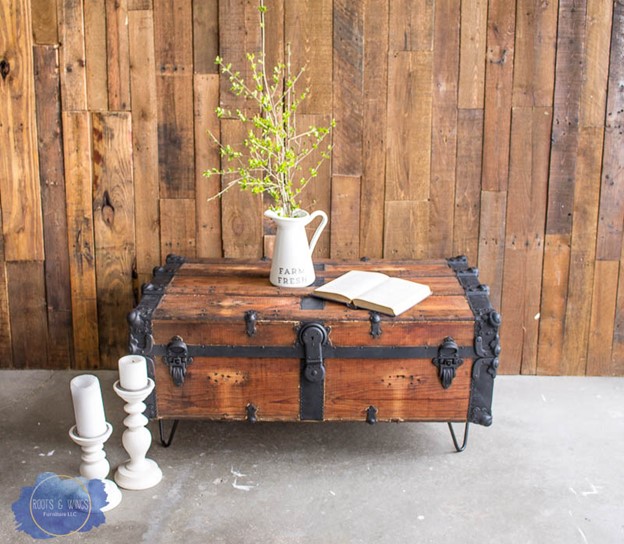
It is no secret that steamer trunks are adored worldwide! There is just something irresistible about a steamer trunk that captivates and compels discovery and ownership.
Are you considering the purchase of a steamer trunk? If so, consider which of the following uses of a steamer trunk you would idealize for your home.
- Coffee Table
- Storage – Blankets, clothing, keepsakes, and anything size friendly!
- Gift for Family or Friends
- Hallway Décor – Set alongside the wall in your hallway and set décor on top.
- Window Plant Holder – Set below the window for showcasing plants.
- Shoe Storage
- End Table for the Bedroom or Living Room
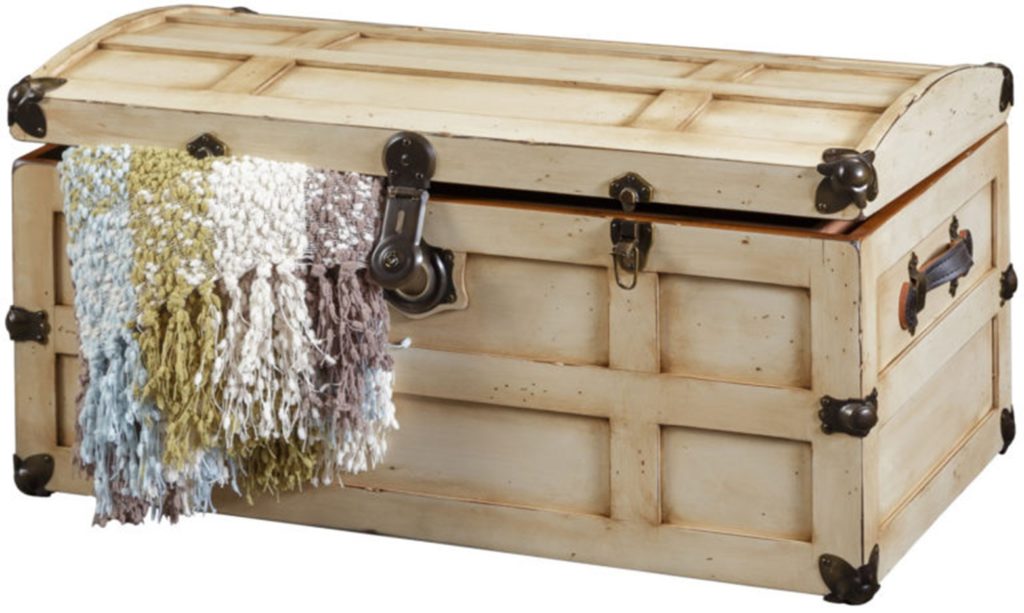
Have you discovered your ideal use? Now all you might need is a beautiful, vintage steamer trunk!
Perhaps you enjoyed the history of steamer trunks and admire the antiques, however, you may prefer to own a brand-new steamer trunk.
Whether antique or modern, a steamer trunk offers a fascinating piece of vintage furniture.
Are you ready to bring a history packed trunk to your home?
If so, take a moment to check out the following quality and intricately crafted steamer trunks. You might just find your perfect fit!
Discover Your Idyllic Steamer Trunk Today!

Just in case you were wondering, the lifeboat you boarded kept afloat until you were heroically rescued by the RMS Carpathia. Unfortunately, your steamer trunk was never seen again.
This real to life, yet imaginary story is over, however, you can bring your imagination to reality today!
The Domed Vintage Steamer Trunk
Is your heart is sold by the attractive curvature of the dome style? If so, a dome style steamer trunk is yours! Plus, you get to choose whether your steamer trunk is handcrafted from maple, hickory, or oak. Many more customization options await such as hardware, sizes, and more! This historical beauty will certainly ravish not only you but all your friends and family!
View the Dome Style Vintage Steamer Trunk

The Flat Lid Vintage Steamer Trunk
Do you wish to turn your steamer trunk into a coffee table or spot for adding décor? The Flat Lid steamer trunk offers you the most versatility of use. ( Just like it always has throughout its history😊 ) Enjoy choosing your favorite wood, hardware, and size. Revel in the pride of contributing to the admiration and history of steamer trunks!
Click on the button below to view flat Lid Vintage Steamer Trunks
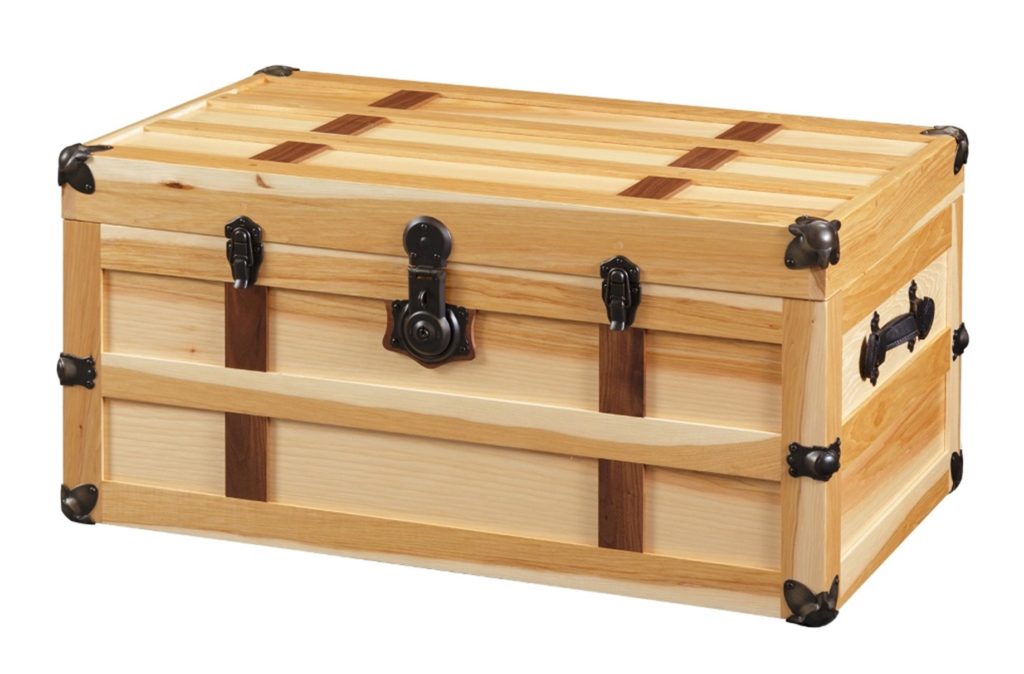
Thank you for reading, hopefully you’ve learned more about what is a steamer trunk.
Reader Interactions
September 28, 2021 at 11:55 pm
Hello I have a unique trunk im looking to sale it can you point me in any direction I’m willing to send pictures.
Christian Sparks
November 27, 2021 at 8:29 pm
Do y’all know where I can take my antique steamer chest to be refurbished? I want it to remain as close to the original as possible.
Josh Stoltzfus
December 9, 2021 at 11:31 am
Hello Christian, It is hard to recommend someone who could help with this without knowing your area. However, I would look online for “furniture doctor near me” The Furniture Doctor company has several locations through the US. They may be able to help you out.
Thanks! Josh
Leave a Reply Cancel reply
Your email address will not be published. Required fields are marked *
Save my name, email, and website in this browser for the next time I comment.

The Steamer Trunk: Iconic Antique Luggage
Quill And Fox
Best Design Studio

Amber Robertson
Amber Robertson is the founder of Quill and Fox. A creative writing studio that helps people find their voice and share their stories. Amber is also a published author, with her first book slated for release in 2020. She loves spending time with her family and friends, reading, writing, and traveling. When Amber was younger, she loved to write short stories and plays. But somewhere along the way, she lost touch with her creativity. It wasn’t until she became a mom that she realized how important it was to share her stories—both the good and the bad—with the people she loves most. That’s when Quill and Fox was born. Amber is passionate about helping others find their voice and share their stories. She believes that every person has a story worth telling, and it’s her mission to help them tell it in a way that is authentic and true to themselves
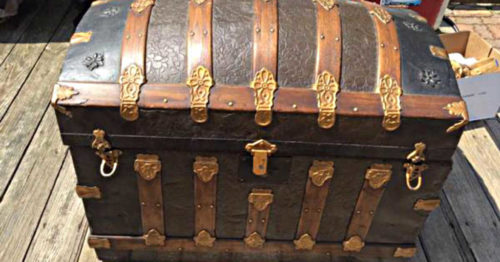
How to date an antique steamer trunk?
Table of Contents
Dating an antique steamer trunk can be a difficult task. There are many things to consider, such as the age of the trunk, where it was made, and who made it. With a little bit of research, though, you can date your steamer trunk with ease. In this blog post, we will explore some tips for dating your antique steamer trunk.
If you’re in the market for an antique steamer trunk, there are a few things you need to know before buying. Here is a guide on how to date an antique steamer trunk and make sure you’re getting the best deal possible. Enjoy!
Antique Trunks: Identification And Value Guide
If you’re a fan of Antique Trunks, then you’ll be glad to know that there are plenty of ways to find them. You can check out Antique Stores, Auctions, and even online retailers that sell Antique Trunks. Here are some tips on how to find Antique Trunks for sale:
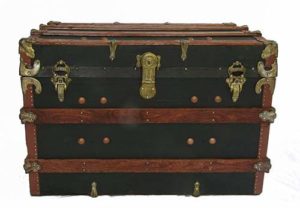
– Antique Stores: If you have an Antique Store near you, they might carry Antique Trunks. Give them a call or visit their website to see if they have any in stock.
– Auctions: Another great place to look for Antique Trunks is at auctions. You can often find good deals on Antique Trunks at auction websites like eBay.
– Online Retailers: There are a number of online retailers that sell Antique Trunks. Take some time to browse around and see if you can find a retailer that has the perfect Antique Trunk for you.
History Of Antique Trunks In Brief
The history of antique trunks is a long and interesting one. Trunks have been used for centuries to store and transport belongings, and they continue to be popular today. Many people use antique trunks as decorative pieces in their homes, and they are often passed down from generation to generation.
Trunks were first used in the ancient world for storing weapons and other valuables. They were often made of wood or metal, and sometimes decorated with intricate carvings or paintings. During the Middle Ages, trunks became increasingly popular as a way to transport goods between cities. By the Renaissance, trunks were common among wealthy families who used them to store their finest clothing and other possessions.
In the nineteenth century, trunks became increasingly standardised in size and design. They were often used by travellers to store their belongings while on the road. Today, antique trunks are still popular as decorative pieces and storage solutions. Many people use them to store items such as clothes, linens, and books. Others use them as coffee tables or side tables. Whatever their purpose, antique trunks add a touch of history and charm to any home.
Different Types Of Antique Trunks
There are numerous types of antique trunks available on the market, each with their own unique style and history. Here is a list of some of the most popular types of antique trunks:
1. Steamer Trunk: Steamer trunks were originally used by travelers in the 1800s as a way to transport their belongings while traveling by ship. These trunks are characterized by their flat top and bottom, which allowed them to be easily stacked on top of one another. The sides of steamer trunks are usually made of wood, with metal straps and handles for added durability.
2. Dome Top Trunk: Dome top trunks get their name from their domed lid, which was originally designed to protect the contents of the trunk from the elements. These trunks are often made of wood or wicker, and were popular in the late 1800s and early 1900s.
3. Wardrobe Trunk: Wardrobe trunks were originally designed to transport a person’s clothing and other belongings while traveling. These trunks are tall and narrow, with a hinged door on one end that opens to reveal a hanging rod for clothes. The other side of the wardrobe trunk typically has drawers or shelves for additional storage.
4. Saratoga Trunk: Saratoga trunks were named after the famous spa town in New York state, and were originally used by wealthy travelers as a way to transport their clothing and other belongings while traveling. These trunks are large and square, with metal reinforcements and handles.
5. Blanket Chest: Blanket chests are a type of trunk that is designed for storing blankets and other large items. These chests are typically made of wood, with a hinged lid on top and a storage area below. Some blanket chests also have drawers built into them for additional storage space.
Whether you are looking for a functional storage piece or a unique conversation starter, an antique trunk is a great option. These trunks come in a variety of styles and sizes, so you are sure to find one that fits your needs. Plus, the history behind these pieces makes them even more special.
Difference Between Trunks & Chests
There is a big difference between trunks and chests. Trunks are designed for storing larger items, while chests are better suited for smaller items. Here’s a more detailed breakdown of the differences:
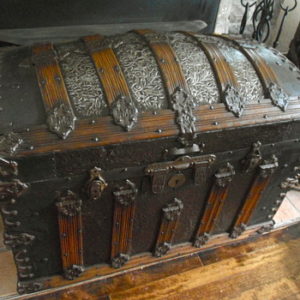
– Are larger in size
– Have more storage space
– Are great for storing bulky or heavy items
– Typically have a flat top, making them ideal for use as a coffee table or extra seating
– Are smaller in size
– Have less storage space
– Are great for storing lighter items or items that need to be organized
– Typically have a hinged lid, making them easy to access
– Can be stacked on top of each other, making them great for small spaces
Noteworthy Brands On Antique Trunks
Some of the most popular and well-known antique trunk brands are listed below.
– H. J. Nick & Sons: This company was founded in 1885 and produced trunks until the early 20th century. The company was based in New York City and their trunks were known for being high quality and durable.
– Wardrobe Trunk Company: This company was founded in 1892 and was based in Chicago, Illinois. Their trunks were known for being stylish and elegant, and they were a popular choice among wealthy Americans.
– Louis Vuitton: This French brand is perhaps one of the most well-known luxury brands in the world. They have been making trunks since 1854, and their iconic monogram design is instantly recognizable.
– Goyard: Another French brand, Goyard has been making trunks since 1853. Their trunks are known for being extremely sturdy and well-made, and they continue to be popular among trunk collectors today.
Expert Tips On Antique Trunk Purchase
-Check for damage and repairs. Inspect the trunk for any signs of damage or repairs. These can affect the value and stability of the piece.
-Consider the size. Make sure the trunk will fit in the desired space, taking into account both width and height.
-Think about function. Will the trunk be used for storage or as a decorative piece? If storage is the primary goal, make sure it is large enough to hold everything you need.
-Evaluate the condition. Antique trunks can be found in a variety of conditions, from mint condition to severely damaged. Consider how much work you are willing to put into restoring a piece before making a purchase.
-Choose the right material. Trunks are typically made from wood, metal, or canvas. Each material has its own advantages and disadvantages in terms of durability, weight, and style.
-Set a budget. Antique trunks can be quite expensive, so it is important to set a budget before beginning your search. This will help you narrow down your options and prevent you from overspending.
Essential Facts To Value Antique Trunks
– Antique trunks are often made of wood, metal or a combination of both materials.
– They were used for storage and transportation purposes, and were often decorated with intricate designs.
– Today, antique trunks are valuable collectibles. Their value is based on factors such as age, condition, rarity and provenance.
– Essential facts to consider when valuing an antique trunk include its material, age, condition, provenance and rarity.
When it comes to valuing antique trunks, there are a few essential facts that you need to keep in mind. First and foremost, the age of the trunk is going to be one of the biggest factors in its value. The older the trunk, the more valuable it is likely to be. Another important factor is the condition of the trunk. If it is in good condition, it will be worth more than a trunk that is in poor condition. Finally, the type of material that the trunk is made from can also impact its value. Trunks made from rare or exotic materials are usually worth more than those made from more common materials. Keep these factors in mind when valuation antique trunks and you should be able to get a good idea of their worth.
There are a few ways to determine the age of an antique steamer trunk. One way is to look for labels or stamps from the manufacturer. Another way is to examine the hardware and materials used in the construction of the trunk. Trunks made before 1860 were usually made of wood, while those made after that date were often made of metal or other synthetic materials. examining the style and construction of the trunk can also give clues as to its age. Early trunks were often quite plain, while later ones often included decorative features such as carved panels or brass fittings.
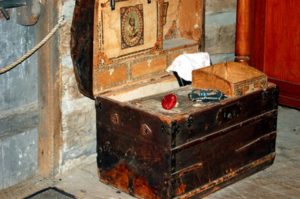
A step by step guide to dating an antique steamer trunk:
1. Examine the overall condition of the trunk. Is it sturdy and in good condition, or is it falling apart? If it’s in poor condition, it’s likely not an antique.
2. Look for labels or stamps on the trunk. These can help date the piece.
3. Check for any identifying marks, such as a maker’s mark or serial number. These can also be helpful in dating the trunk.
4. Measure the trunk. Antique steamer trunks were typically smaller than modern ones, so if the piece you’re examining is very large, it’s probably not an antique.
5. Inspect the hardware on the trunk. Antique trunks would have had hand-forged hardware, rather than mass-produced hardware.
6. Examine the wood of the trunk. If it’s made of cedar or another type of softwood, it’s likely not an antique, as steamer trunks were typically made of hardwoods like oak or mahogany.
7. Look at the construction of the trunk. Antique steamer trunks were generally well-made, with dovetailed joints and strong straps. If the piece you’re looking at is poorly constructed, it’s probably not an antique.
8. Research the piece using online resources or books about antiques. This can help you confirm the age and value of the trunk.
9. Have the trunk appraised by a certified antique appraiser to get an official value for the piece.
Q: How can I tell how old my steamer trunk is?
A: There are a few ways to date an antique steamer trunk. One way is to look at the hardware. The style of hardware can give you a general idea of when the trunk was made. Another way is to look at the markings on the inside of the trunk. Many trunks will have a label or stamp with the name of the manufacturer and the date of production. Finally, consider the overall style of the trunk. Different styles were popular in different eras. By considering all of these factors, you can get a good idea of when an antique steamer trunk was made.
Q: How do I determine the value of my steamer trunk?
A: There are a few factors that can affect the value of an antique steamer trunk. The age, condition, and rarity of the trunk are all important considerations. Generally speaking, older and more rare trunks will be worth more than those that are younger and more common. The condition of the trunk is also important, as trunks that are in good condition will be worth more than those that are damaged or in poor condition.
Q: How can I care for my steamer trunk?
A: There are a few things you can do to care for your antique steamer trunk. First, keep the trunk clean and free of dust. Second, avoid exposing the trunk to extreme temperatures or moisture, as this can cause damage. Finally, if the trunk is stored away for long periods of time, check on it periodically to make sure that it is still in good condition. By following these simple tips, you can help ensure that your steamer trunk will last for many years to come.
Q: Where can I find more information about steamer trunks?
A: If you are interested in learning more about antique steamer trunks, there are a few resources you can consult. First, try searching for books or articles on the subject. There are many great books that have been written about the history of steamer trunks and their value. You can also search online for websites devoted to antique steamer trunks. These sites can be a great source of information on trunk care, value, and history. Finally, consider visiting a local antiques dealer or appraiser. These experts can answer any questions you have and give you more information on your particular trunk.
Q: Can I use my steamer trunk as luggage?
A: While it is possible to use an antique steamer trunk as luggage, it is not advisable. Steamer trunks are not designed for modern travel and can be difficult to transport. Additionally, many antique trunks are valuable and could be damaged during travel. If you do decide to use your steamer trunk as luggage, be sure to pack it carefully and take steps to protect it from damage.
Q: How can I tell if my steamer trunk is authentic?
A: There are a few ways you can tell if your steamer trunk is authentic. One way is to look for a label or stamp with the name of the manufacturer and the date of production. Another way is to examine the hardware. The style of hardware can give you a general idea of when the trunk was made. Finally, consider the overall condition of the trunk. Genuine antique trunks will show signs of wear and age, while fake or reproduction trunks will often be in pristine condition. By considering all of these factors, you can get a good idea of whether or not your steamer trunk is authentic.
If you’re considering buying an antique steamer trunk, be sure to do your research and understand what you’re getting into. It can be a fun and rewarding project, but it takes time and effort to restore an antique steamer trunk properly. Follow these tips, do your research, and have patience – the end result will be worth it!
If you’re interested in dating an antique steamer trunk, it’s important to learn about the different types of trunks and their corresponding age ranges. It’s also helpful to know how to spot a fake trunk. By understanding these things, you’ll be able to date your trunk with confidence and avoid any costly mistakes. Have you ever dated an antique steamer trunk? What tips would you add? Visit our website ” Quill & Fox ” to get more !
How to antique cabinets?
What does antiquing mean? : The art of antiquing: what does it mean and how to do it
Where can I sell antiques near me? :10 Best Places to Sell Antiques
How to antique a mirror ?
- Deal of the Week
- Customers’ Creations
- Shipping Info
Unlock the Art of Trunk Repair with Our Tools & Hardware
Step up your trunk restoration project with our essential trunk tools and hardware available at Brettuns Village.
Our wide selection provides you with the necessary tools to breathe new life into your treasured trunks. Our hardware is designed to match the era and style of your trunk and we ensure that you’ll have a final result that you’ll love — both functional and historically accurate.
You can confidently tackle any repair or restoration project you may have with our premium trunk tools and hardware. At Brettuns Village, we’ve chosen our tools for their precision and ease of use to make even the most intricate trunk restoration projects possible.
Showing 1–12 of 238 results
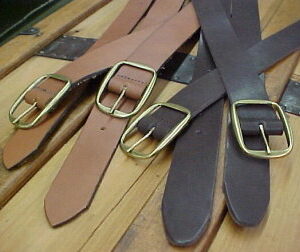
1.25″ Wide Steamer Trunk...
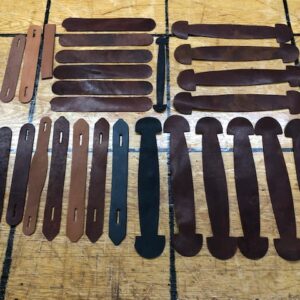
1867 Set of single layer trunk...
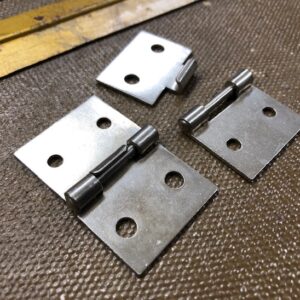
1940 Case Lift-Off Hinges
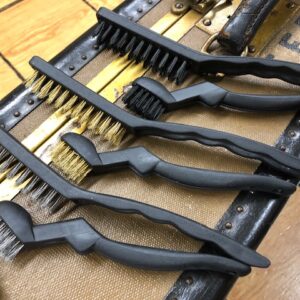
6 Piece Hand Brush Set for Tru...

A small lid support for small ...
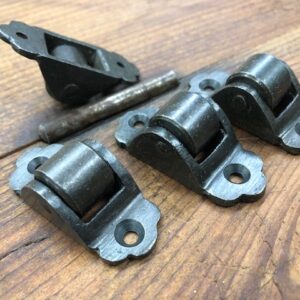
A Steel Flush Mount Trunk Whee...
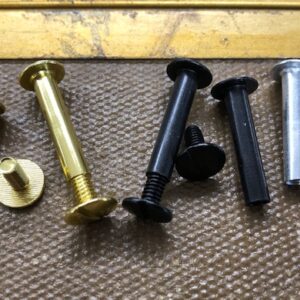
Aluminum Binder Posts (Chicago...
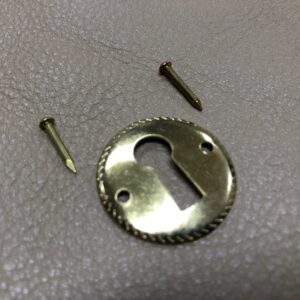
Another Style of Keyhole
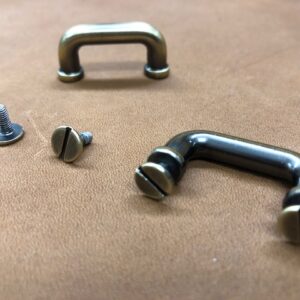
Antique Brass Finish Handle Lo...
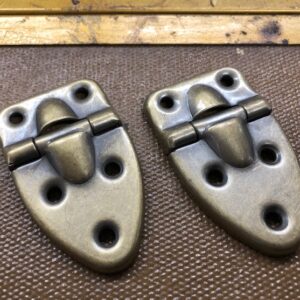
Antique Brass Finish Trunk Sto...
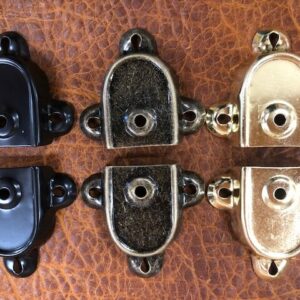
Antique Brass or Bright Brass ...
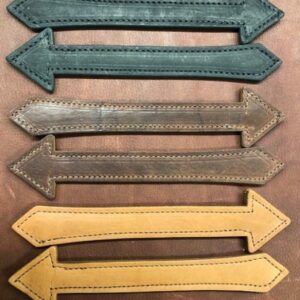
Arrow Head End Saratoga and Je...

IMAGES
VIDEO
COMMENTS
Leather Trunk Handle with Pointed Ends. $12.85. 1 2. Unearth trunk restoration treasures at Restoration Supplies. From hardware to finishes, breathe new life into vintage trunks with our curated collection.
We can expertly repair, refinish and restore your antique trunk, making it a possession that you will be proud to own. Once restored, it will last for generations, and will be a centerpiece heirloom. We can restore any antique trunk back to its original condition so that it looks the way it did 100 years ago.
Step 3: Sand Your Antique Trunk. To restore your antique trunk's finish, you'll need to sand it down the outer slats to remove any old paint, varnish, or stain. Start with a coarse-grit sandpaper and work your way up to a finer grit. Be sure to sand in the direction of the wood grain to avoid leaving scratches.
Dealers and Restorers of Steamer Trunks, Antique Phonographs & Hardware. Contact Us: 1-800-575-1960 / 580-951-0234. Email: [email protected]. Order our New Catalog and Price List. Complete listing of: Furniture, Hoosier. Cabinet, Trunk, Telephone, Chair Caning, Wood Parts/Veneer, Oil Lamp Hardware,
Lightly spray the paper, but don't soak the inside of the trunk. Place the trunk outside in the sun to remove odors. You can also spray it with a weak bleach solution if you suspect mold. Remove rusty parts and use a wire brush or sandpaper to scrape off the rust. Remove rotten leather and other damaged parts.
Complete re-lining of inside in paper, with Victorian Artwork and corner tapes included. Final Touch up and Clear Coating the entire outside of the trunk. $450.00 - for a child-size or doll trunk under 22". $500.00 - Small 23"-28" length Small Trunk. $600.00 - Medium 29"-33" length Medium Trunk. $650.00 - Large 34" + length Large ...
This antique trunk restoration project shows you how to restore an old trunk. If you need help with an old trunk restoration then follow along and see how to restore a steamer trunk. ... These sturdy wooden travel chests were popular in the late 1800s and early 1900s for those traveling long distances aboard these ships.
ANTIQUE TRUNK RESTORATION & DESIGN has devoted the past twenty years to the preservation, repair, refinishing and restoration of every variety of antique and vintage trunk. In addition, they typically design and construct over 100 trunks per year. Worldwide clients include major corporations, high profile families, Hollywood producers and ...
Apply the stain with a brush or cloth, making sure to cover the entire surface of the trunk. Allow the stain to sit for the recommended amount of time, then wipe away any excess with a clean cloth. Be sure to wear gloves and work in a well-ventilated area to avoid inhaling fumes or staining your skin.
Antique Trunk Restoration & Design is a dynamic and creative entity with over twenty years of experience in antiques, trunk building and restoration for all. The company specializes in the restoration and repair of antique trunks of all makes and varieties, from American built Martin Maier, to the elite French brand of Louis Vuitton. ...
www.antiquetrunksandchests.comLearn how to restore an antique trunk. Visit our website for additional information about antique trunk values, FAQ about trunk...
Today, finding, restoring, and repurposing vintage travel trunks is popular and fun. Before getting started, learn to recognize a heavier grade candidate for restoration. Paul is celebrating 40 years in the antiques trade. He started out by salvaging a family trunk when he was 9 years old, and today collects Sample trunks and overbuilt ...
Another Antique Trunk has wandered into the shop...and it's a BIG one. ALL PRODUCTS I USED ON THIS PROJECT ARE PINNED IN THE COMMENTS SECTION 👍I come across...
Restoring a Vintage Steamer Trunk: Trunk restoration is a combination of wood working, metal craft and leather work, so it helps to have some experience in all three fields. The hardest part of the entire project is in the preparation of the piece. Removing the old material covering …
These steamer trunks were mostly flat tops and were designed for traveling purposes and to fit in small spaces. They were square-shaped or dome-shaped and were used to put clothes and personal belongings in when people traveled. Due to luggage regulations, steamer trunks were usually not more than 14 inches tall.
Today, antique trunks continue to hold value and can be great centerpieces for many interior decoration styles. But like all vintage pieces, their cosmetic condition is key to their value. Antique trunk restoration can be challenging, but with the helpful hints below you can proudly display your beloved antique trunk. Step 1: Prepare the Trunk
So TODAY is the day to get this project underway! The longer that your trunk sits in your basement, or garage or attic, means less time that you will have to be able to enjoy it. Get in touch with the experts on how to restore antique wardrobe trunks right now! 760 699-8156.
A steamer trunk is a square or domed shaped storage box used for packing clothing and other personal belongings for travel. The box got coined with the name steamer trunk thanks to its use aboard steam powered ships. Yes, steam powered ships like the Titanic, RMS Carpathia, RMS Queen Elizabeth, and SS Bremen.
The Steamer Trunk: Iconic Antique Luggage. A complete guide to STEAMER TRUNKS, awesome vintage finds that can be used for all sorts of things today, from seating to storage.
A: There are a few ways you can tell if your steamer trunk is authentic. One way is to look for a label or stamp with the name of the manufacturer and the date of production. Another way is to examine the hardware. The style of hardware can give you a general idea of when the trunk was made.
Lithographs, Maker Tags & Travel Stickers Discover an even more unique antique trunk with our lithographs, maker tags, and travel stickers. These small details make a difference in trunk restoration and decorations. Our products are crafted with precision and attention to detail, adding a touch of authenticity to any of your trunk projects.
At 1stDibs, there are several options of antique steamer trunks available for sale. Each of these unique antique steamer trunks was constructed with extraordinary care, often using metal, wood and animal skin.There are all kinds of antique steamer trunks available, from those produced as long ago as the 18th Century to those made as recently as the 20th Century.